

- ALL MOUNTAIN
- ACCESSORIES
- ALL (130 Forums)
- WHEELS & TIRES

Trek 920 Bike 1998 or Older

- USER REVIEWS
Bought in mid 90's with minimal usage Now considering whether or not suitable for an ebike conversion.
No know weaknesses
Old bike, still all original and working fine
Nice bike, bought it for € 30,00. Had a few hours work to get it all working good again. I think it stood still for about 10 years. Just had to put some air in the tires, and I could mount it :)
Similar Products Used:
Frame! Light, durable. Some fine system1 and system2 TREK components. For those days. I just like it the way it is. It is a fine bike for the weekend as well as for commuting to work. I've used it for MTB touring, up- and down-hill. It still works.
Brakes. Good thing you can replace them with V-brakes. Alivio crankset. Heavy. Wears out fast. The damn anti chain suck plate. Remove that one immediately or it will damage the chain and/or frame. Those funny reflectors in the wheels, back and front :-)
Best bike I have owned. If maintained well it goes on forever. You can attach fenders and other stuff easily.
None. In fact I've bought a second one in 2011 which is original and great condition. I did enjoy other bikes but never bought them. No need for suspension. And another Trek : the 930 version. Dated 1996 based on the serial number in the frame. Alas, this frame is not that good looking nor responsive. The 930 had a better drivetrain but the other components are less compared to the older 920. So that one will go soon.
strong TRUE TEMPER OX COMP frame,size S
frame too small for rear V brake
fast and lovely ride,dreaming about new 920...
SUNN URGE 999
Perfect single track geometry, strong frame and fork, stable wheels, lovely ride.
Cheap and heavy bottom bracket (even lasted ten years), plastic pedals.
I am the first owner of this bike purchased in 1995. Jumped to Shimano SPD pedals and Selle Italia saddle after few years. I have cycled about 10.000 km on the road, mountains, dirt and no complaint at all. I changed the bottom bracket, the cassette and the crankset with a new Deore last year and the headset with Deore XT (1994) last month, first time. I think the new mass production aluminium Treks cannot measure swords with this old boy. It is the bike that takes you where you want to go; moreover you can race on it with some modifications, e.g. a light suspension fork. It is a long touring bike with appropriate tires, which has suitable braze-ons. If I had one bike only it would be a Trek 920.
Look KG171 and Motobecane Mirage road racing bikes.
Man, this bike ruled. I had the 94' model 920 (completely rigid), and I still managed to keep up with my friend on his front suspended Schwinn. Rock solid frame, decent geometry, and the lovely feel of steel!
Uhm, the parts were pretty low quality for the riding that they got, but what do you expect on a little entry leveler like this? The quill stem, which is still on the bike is kinda sketchy. I'm turning this bike into a single-speed, and while trying to keep as much original equipment as possible, I thing the stem is going to have to go :(
If you could even find one of these bikes around anymore, I would snatch it up. A reliable bike, the 920 did what it was designed to do...get people on a bike and give them a good enough experience so that they continued biking. While parts weren't the greatest, the bike is a great bike. So many chances to upgrade, but still maintaining the sturdy CrMo construction, the 920 will be able to take you places that any other bike could. Wanna see one beadblasted and turned into a single speed? just ask!
Schwinn Mesa, Huffy, TREK Bruiser ;)
It's incredibly lightweight and durable as well as adaptive and multi-purpose. Quick and easy size adjustment also goes a long way.
It's a maintain bike and needs some serious road tires to get around town at a decent speed and level of ease. It is difficult to properly install the rear mudguard, etc, due to the non-standard threaded hole location - I found the front one easier to install, though.
I haven't yet figured out what's been updated and what hasn't on my particular bike. I have an excellent, cushy seat, and it looks like the wheelset has been replaced. I have noticed that it operates best when kept in a single gear, surprise surprise. It's lightweight enough that is can easily be thrown onto a bus bike rack in a hurry, carried up a flight of stairs after a long ride, or hung without fear. It's also not so lightweight that one would be afraid of banging it up. I've read that it makesa great touring bike, and so far I would have to agree. The handlebars and seat adjust quickly and easily to suit a variety of body types and sizes. In essence, if you're a little guy (like me) or gal looking for a sturdy bike that you can carry up the stairs with one hand, it's perfect. It is definitely a great beginner's bike, and I think that it could be customized to suit a pro also.
Solid upgradable frame
No Ahead set.
My wife bought this bike about 3 months ago. So far its been a great bike for the money. The ridgid fork is 1st in line for an upgrade to shocks. Any other owners got any advice on wear and tear and maintenance?
Awsome biginner bike, i f you are a parent and your kids wants a nice bike give them the tre 920 or 930
STX or lower
solid for begginers, but now i break it every week, i dont think a bike could hold up to me though i kill them, mud snow hill's it has well over 30,000 miles on it, and i just put it in the garage for retirment, now i will have to spen real money on a bike. i rate 5 stars only for begginers only if you are good then 1 star
Price/Performance great.
Some low-end components.
Bought in April 1998. Ridden 875 miles since. I think for the money, I got a very good bike. I had no problems for the 1st year. Got me in the game. I did break the chain after only 450 miles. My ignorance left a stiff link become a failure.I put an Answer Manitou SX-R fork, WTB GreaseGuard headset and generic stem on it this year ('99) and I'm more than satisfied.I started racing & beating guys on $1000+ bikes.
Get the latest mountain bike reviews, news, race results, and much more by signing up for the MTBR Newsletter
Hot Deals See All Hot Deals >>
- CLASSIFIEDS
- TERMS OF USE
- PRIVACY POLICY
- ADVERTISING
VISIT US AT
© Copyright 2024 VerticalScope Inc. All rights reserved.
90s Trek MTBs - Steel frames, rigid forks, 26" wheels

Full list of steel, rigid fork mountain bike models Trek made between 1990 and 1999, grouped by year, containing details on frames and main components for easy reference.
Based on riding style, build level and performance, Trek offered these in two series. The 9XX series , called Single Track , consists of a range of race, competition and performance bikes, aimed at pro riders and serious off-road enthusiasts. The 8XX series , called Antelope until 1993 and Mountain Track from 1994, covers a range of multipurpose models, from commuting and recreation to trail and light mountain biking.
1990 View catalog
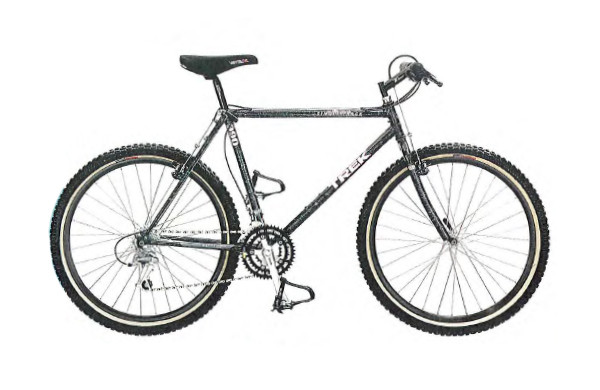
Trek 990 Single Track (1990)

Trek 970 Single Track (1990)

Trek 950 Single Track (1990)
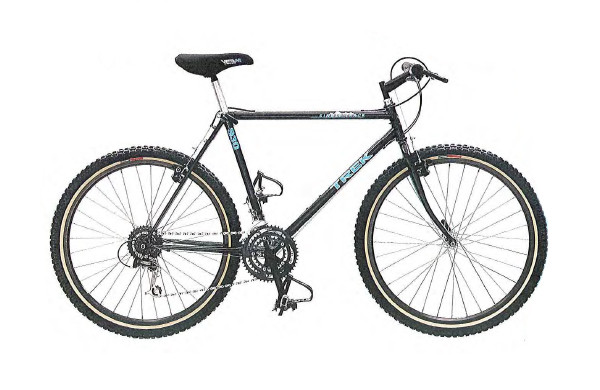
Trek 930 Single Track (1990)
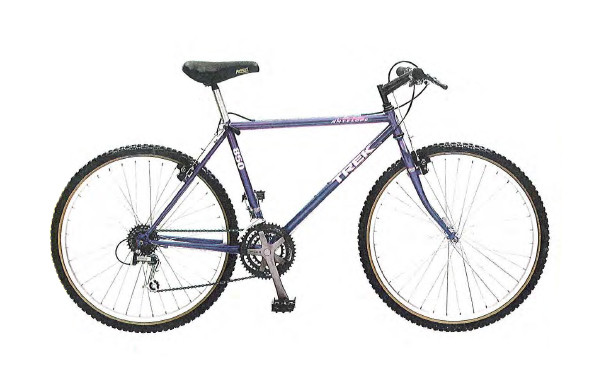
Trek 850 Antelope (1990)

Trek 830 Antelope (1990)
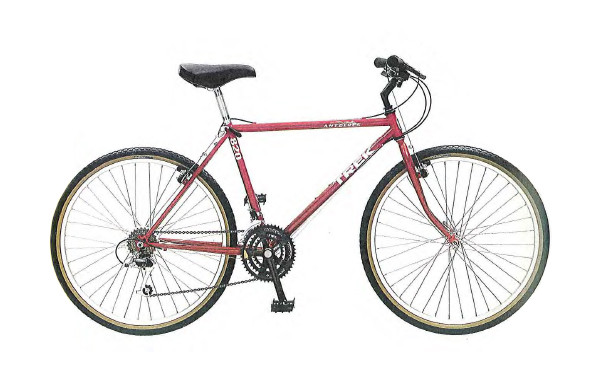
Trek 820 Antelope (1990)

Trek 800 Antelope (1990)
1991 view catalog.
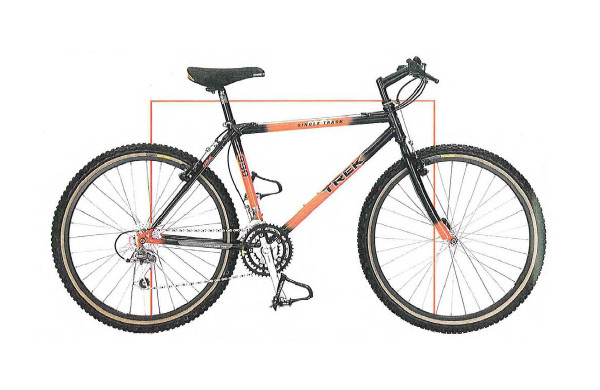
Trek 990 Single Track Competition (1991)

Trek 970 Single Track Competition (1991)

Trek 950 Single Track Performance (1991)
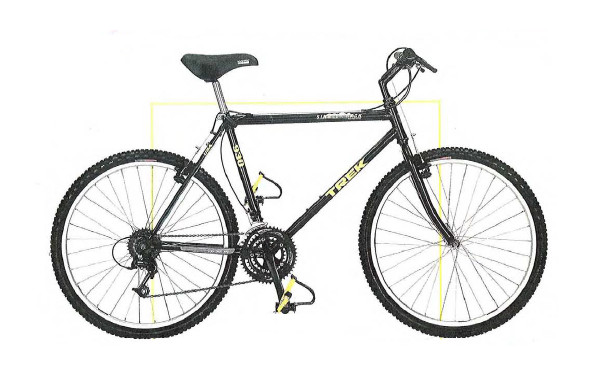
Trek 930 Single Track Performance (1991)

Trek 850 Antelope Performance (1991)
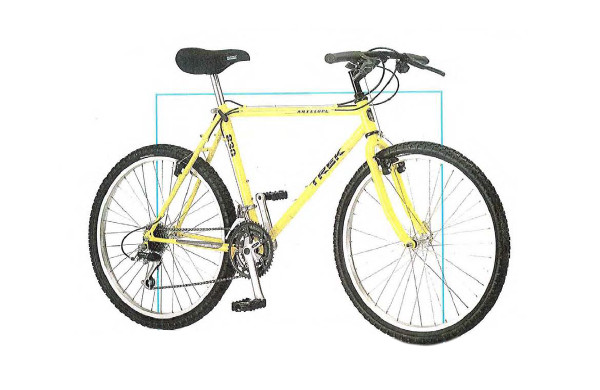
Trek 830 Antelope Mountain Sport (1991)
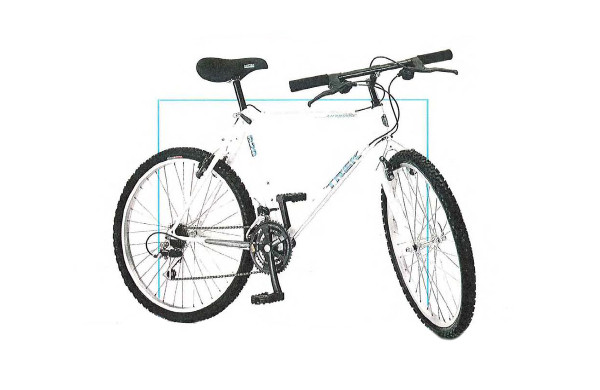
Trek 820 Antelope Trail Performance (1991)
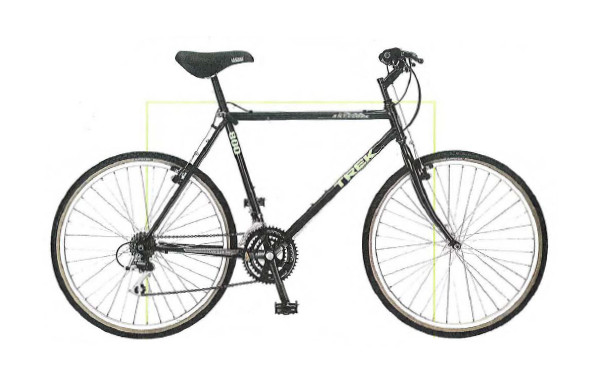
Trek 800 Antelope Sport Trail (1991)
1992 view catalog.
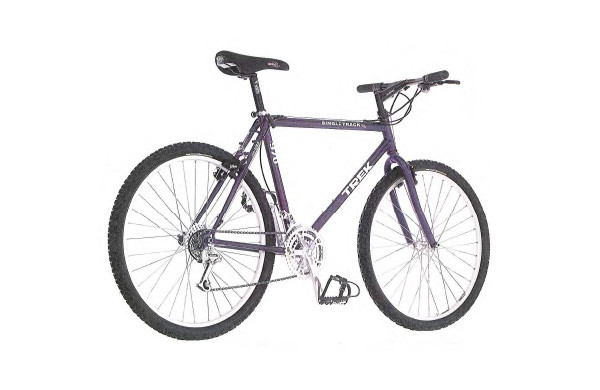
Trek 970 SingleTrack Competition (1992)
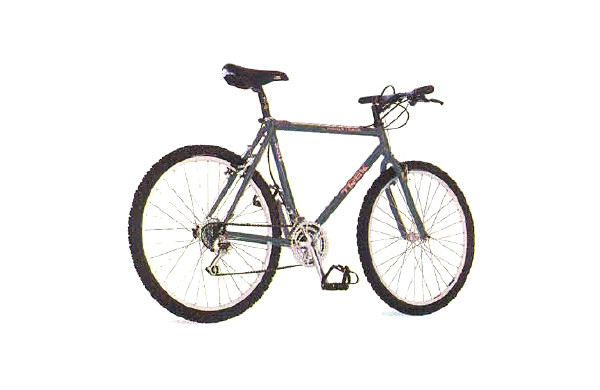
Trek 950 SingleTrack Performance (1992)
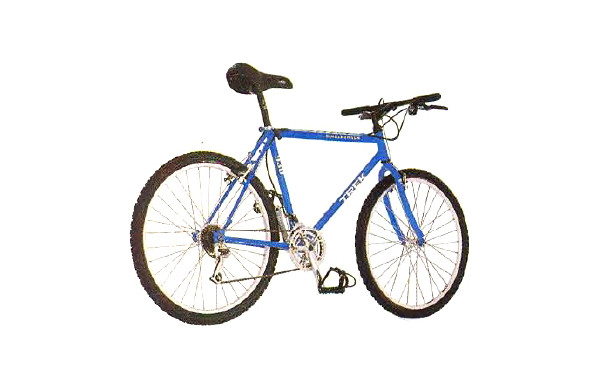
Trek 930 SingleTrack Performance (1992)
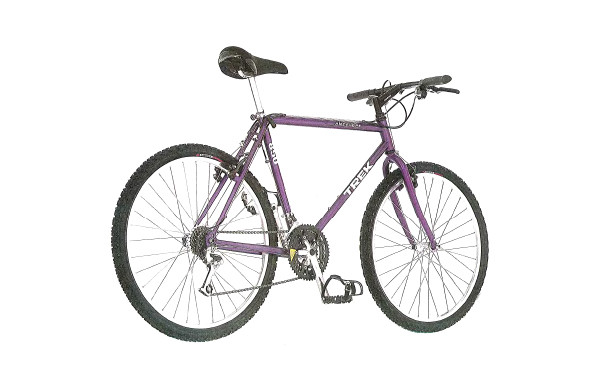
Trek 850 Antelope Performance (1992)
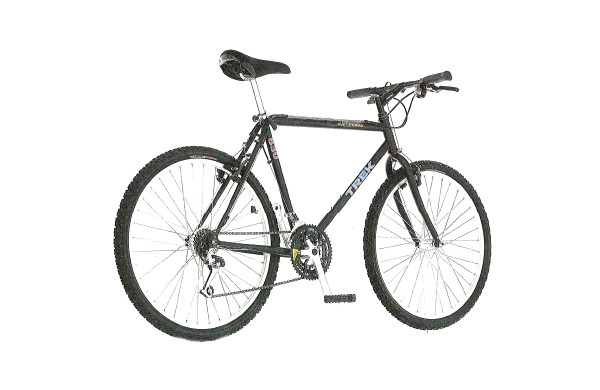
Trek 830 Antelope Trail Performance (1992)
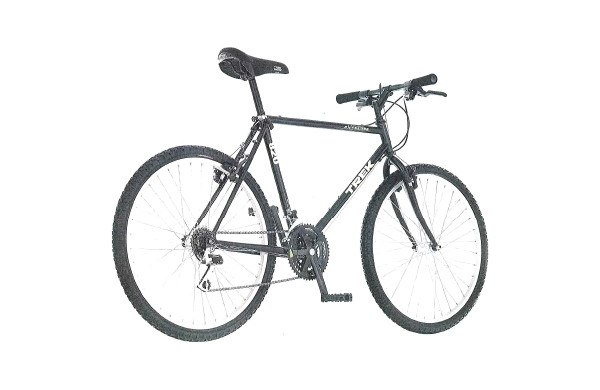
Trek 820 Antelope Sport Trail (1992)
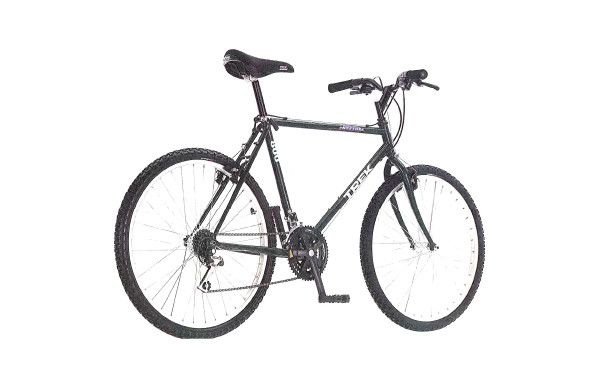
Trek 800 Antelope Sport Trail (1992)
1993 view catalog.
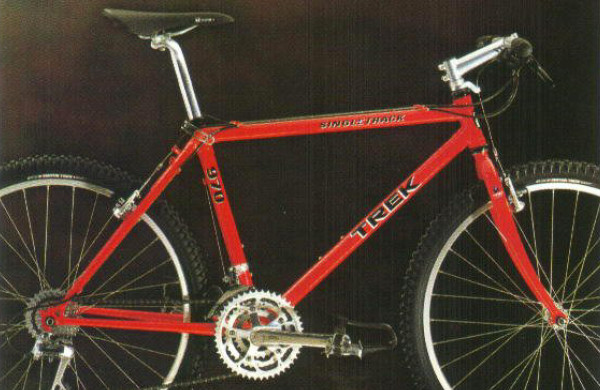
Trek 970 SingleTrack Competition Race (1993)
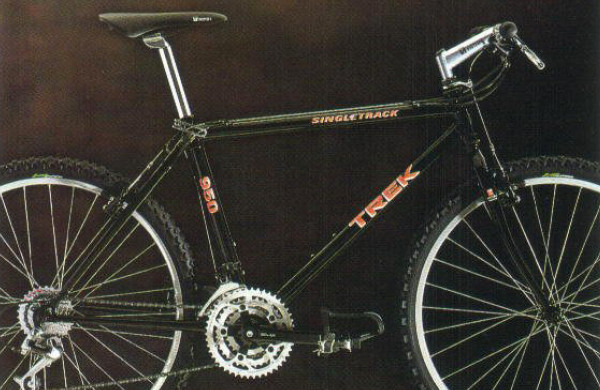
Trek 950 SingleTrack Performance (1993)
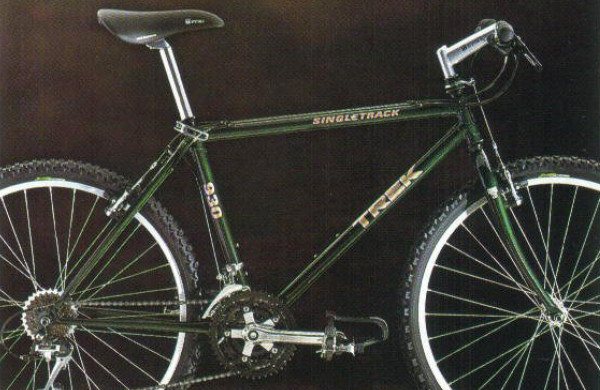
Trek 930 SingleTrack Performance (1993)
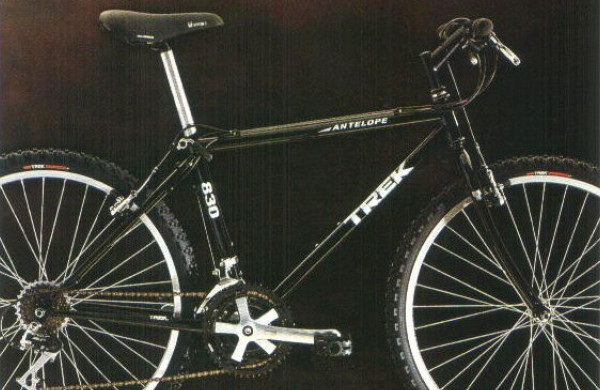
Trek 830 Antelope Performance Trail (1993)

Trek 820 Antelope Sport Trail (1993)

Trek 800 Antelope Sport (1993)
1994 view catalog.
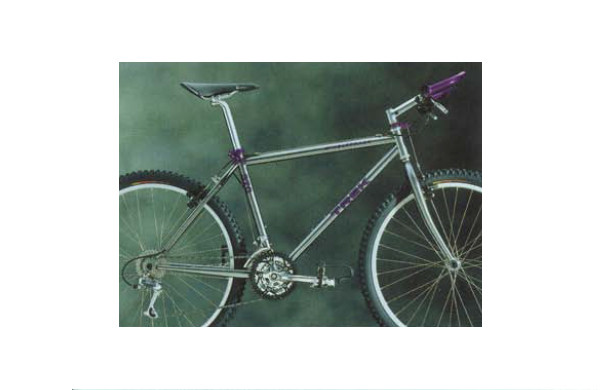
Trek 970 SingleTrack Competition (1994)
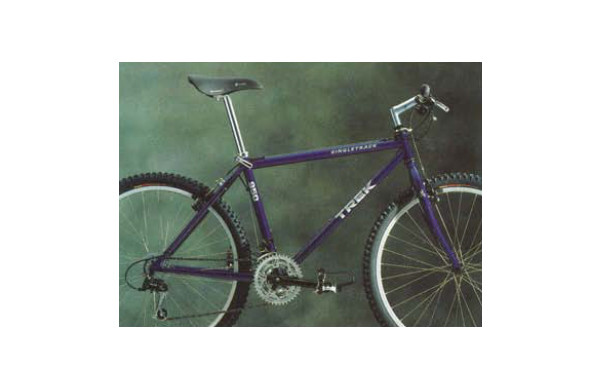
Trek 950 SingleTrack Performance (1994)
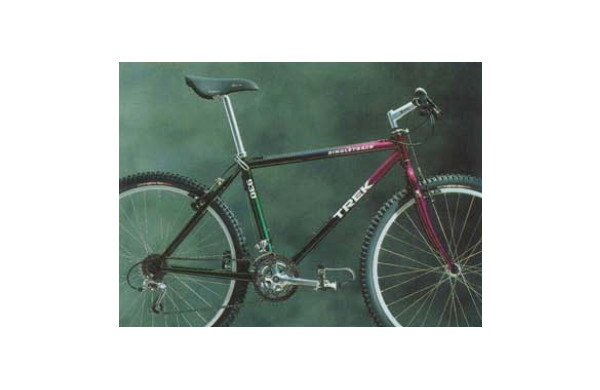
Trek 930 SingleTrack Performance (1994)

Trek 920 SingleTrack Performance (1994)

Trek 850 Mountain Track Performance (1994)
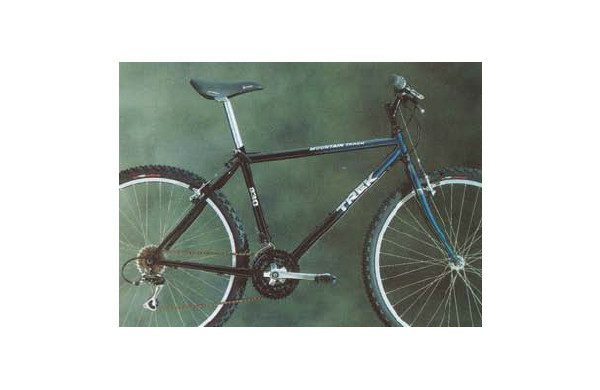
Trek 830 Mountain Track Performance Trail
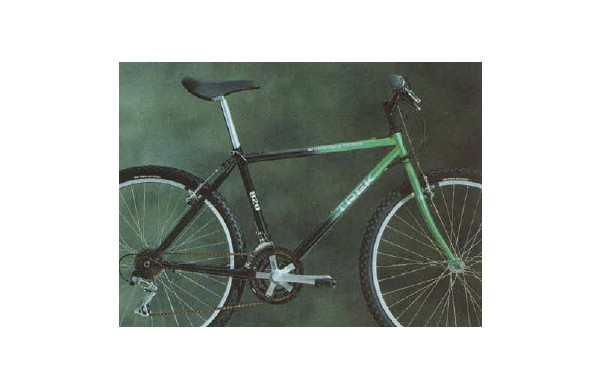
Trek 820 Mountain Track Sport Trail (1994)

Trek 800 Mountain Track Sport (1994)
1995 view catalog.
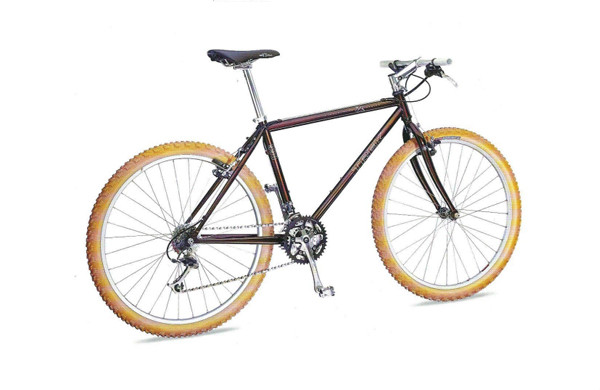
Trek 990 SingleTrack ZX Series Competition (1995)

Trek 970 SingleTrack ZX Series Performance

Trek 950 SingleTrack Performance (1995)
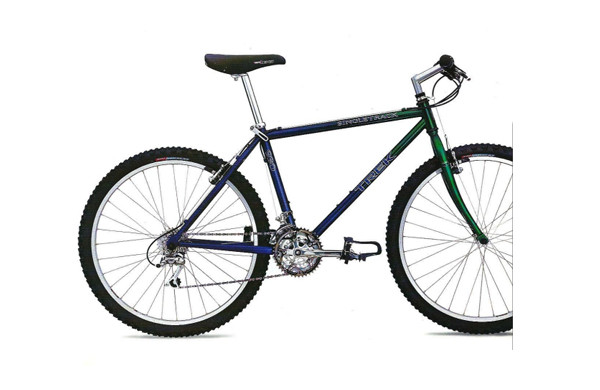
Trek 930 SingleTrack Performance (1995)
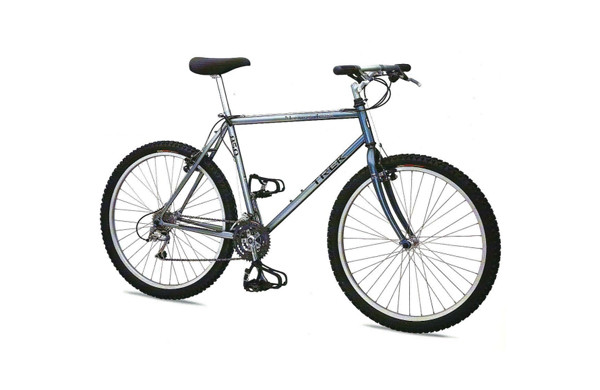
Trek 850 Mountain Track Sport (1995)
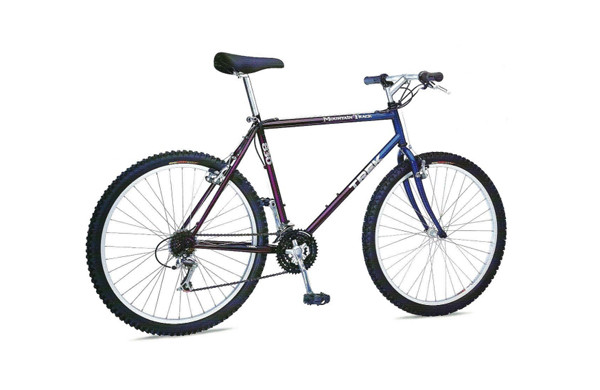
Trek 830 Mountain Track Sport (1995)
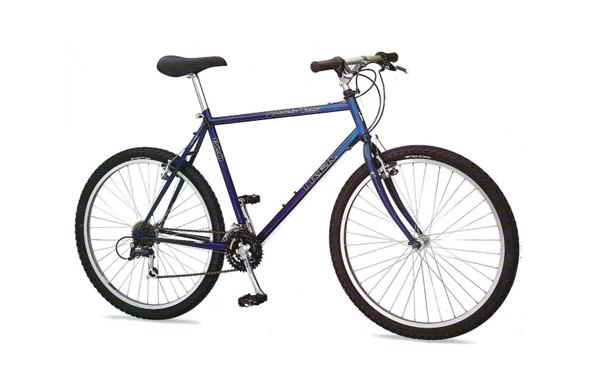
Trek 820 Mountain Track Recreation (1995)
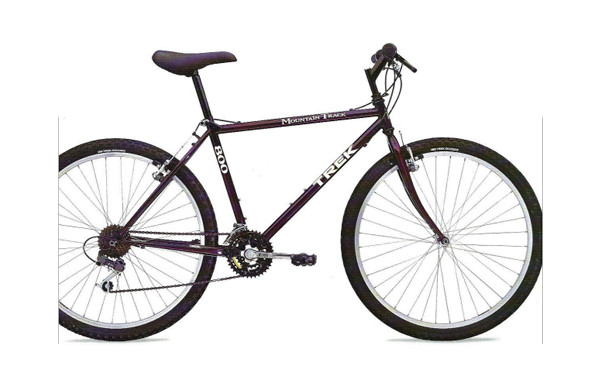
Trek 800 Mountain Track Recreation (1995)
1996 view catalog.

Trek 990 SingleTrack ZX Series Competition (1996)
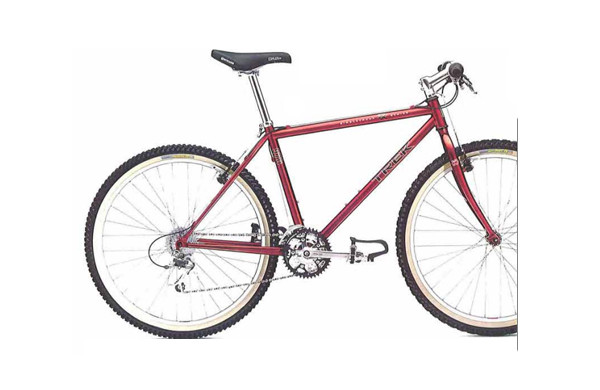
Trek 970 SingleTrack ZX Series High Performance (1996)
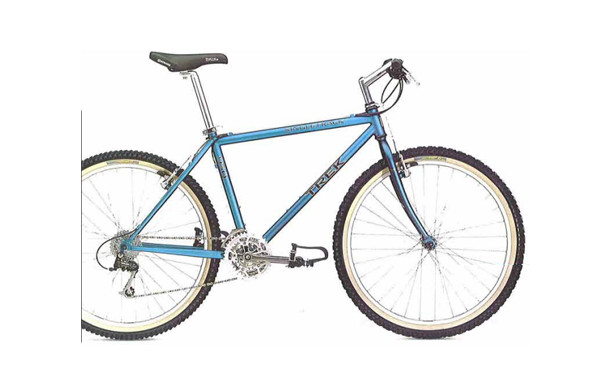
Trek 950 SingleTrack High Performance (1996)
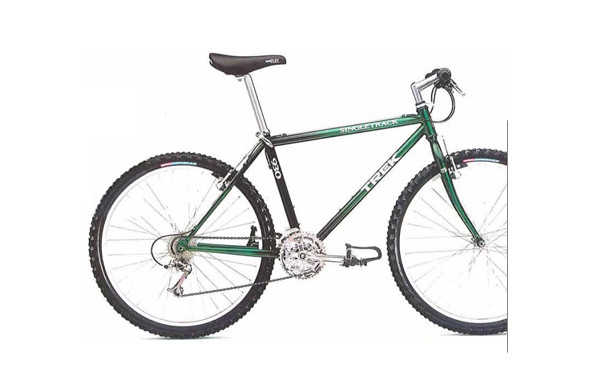
Trek 930 SingleTrack Performance (1996)
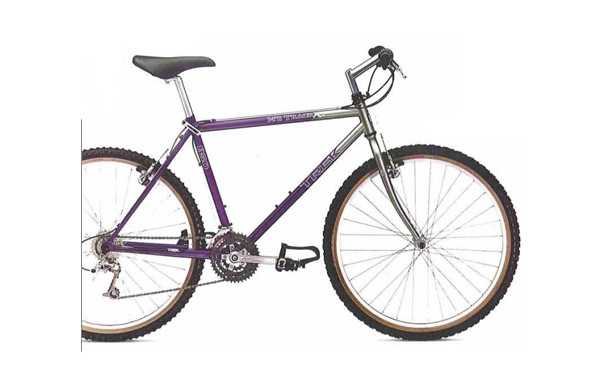
Trek 850 Mountain Track XC Enthusiast (1996)

Trek 830 Mountain Track XC Enthusiast (1996)

Trek 820 Mountain Track Recreation (1996)
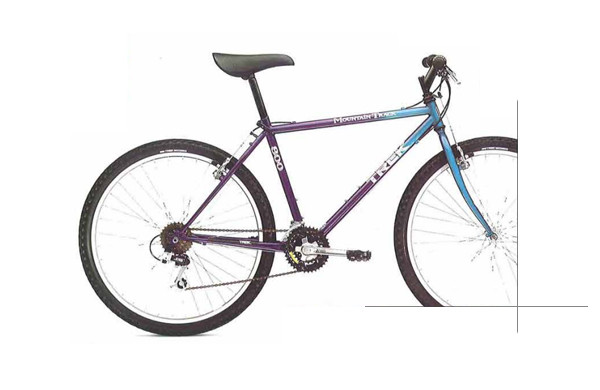
Trek 800 Mountain Track Recreation (1996)

Trek 800 Sport Mountain Track Recreation (1996)
1997 view catalog.

Trek 930 SingleTrack XC Series Performance (1997)
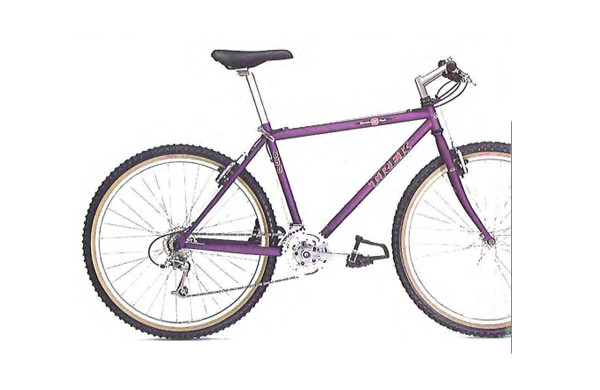
Trek 850 Mountain Track XC Series Enthusiast (1997)
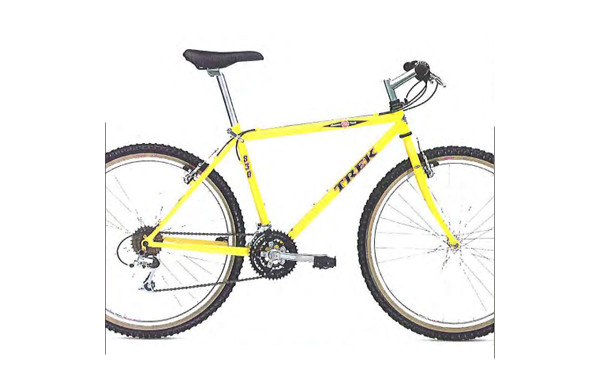
Trek 830 Mountain Track XC Series Enthusiast (1997)

Trek 820 Mountain Track Recreation (1997)

Trek 800 Mountain Track Recreation (1997)
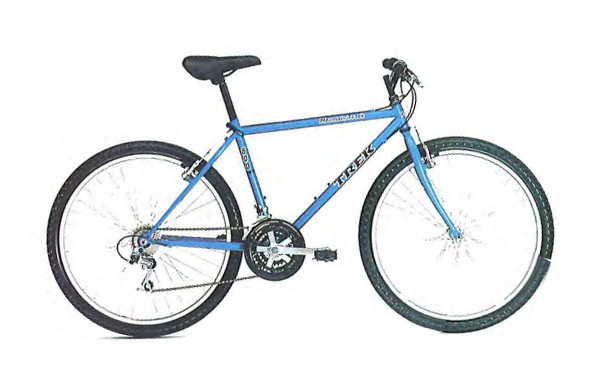
Trek 800 Sport Mountain Track Recreation (1997)
1998 view catalog.
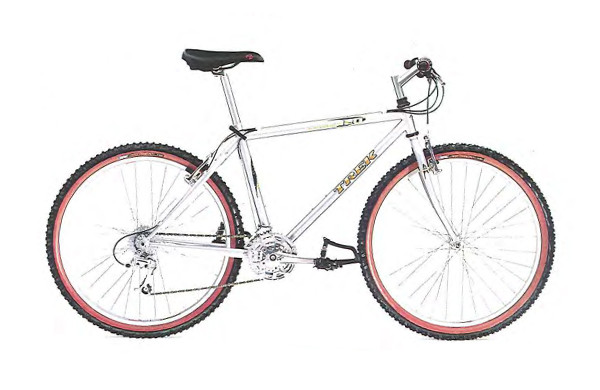
Trek 920 SingleTrack Performance (1998)
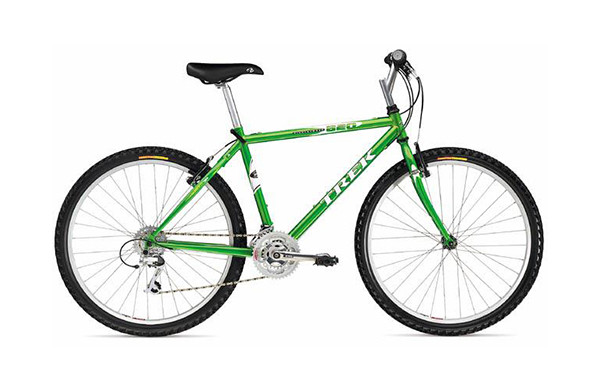
Trek 820 Mountain Track Enthusiast (1998)

Trek 800 Mountain Track Recreation (1998)
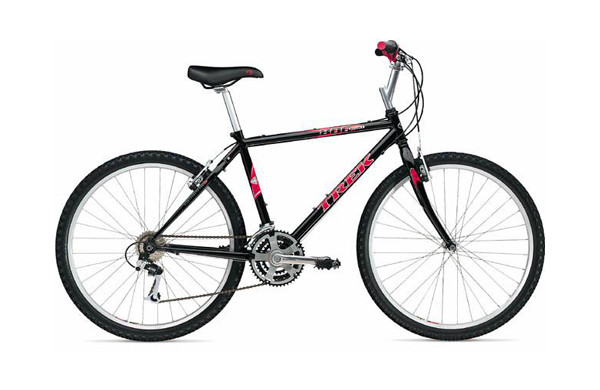
Trek 800 Sport Mountain Track Recreation (1998)
1999 view catalog.
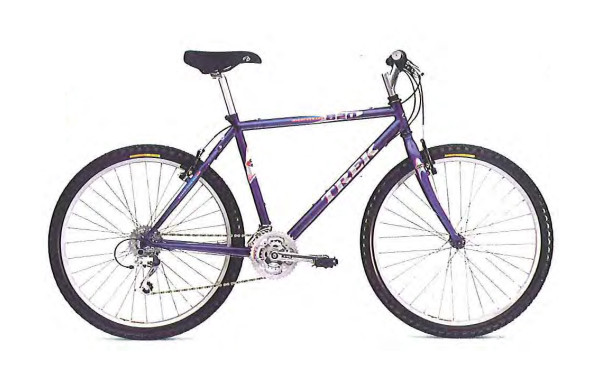
Trek 820 Mountain Track Recreation (1999)
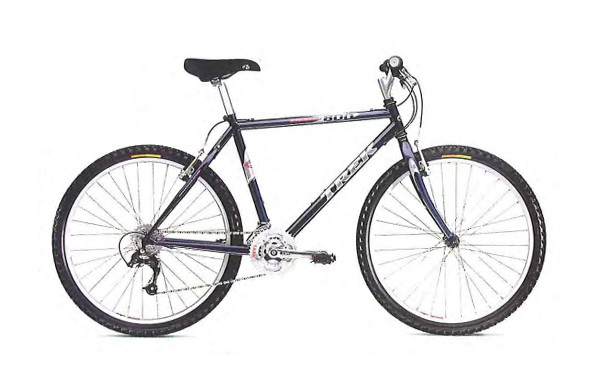

Trek 800 Mountain Track Recreation (1999)

Trek 800 Sport Mountain Track Recreation (1999)
Acronym for all terrain bike.
Trek's exclusive fork design.
A tube having different wall thicknesses along its length, while its diameter remains constant.
Low alloy steel with a medium carbon content, that gets its name from the primary alloying elements, chromium and molybendium. It has an excellent strength to weight ratio and is considerably stronger, harder more durable than mild carbon steel.
Trek's exclusive fork design using taper gauge tubing and provides a blade with more elasticity for better shock absoption.
The thickness of the tube at both ends is thicker than in the centre.
Shifting system, where part of the handlebar grip rotates back and forth, clicking into each gear.
Low alloy steel that can withstand significant stress before breaking or becoming deformed. The term 'tensile' refers to the amount of stress a material can endure before failing.
Steel tubing connected with socket-like sleeves, called lugs.
Shimano's multi-condition brake system with specialized shoes, levers and cables designed for enhanced stopping power in rain, mud and snow.
A house brand for Trek during the 80s and early 90s.
Optimal Dimension; Trek's large diameter, thin wall tubing design.
Oversize; Trek's large diameter, thin wall tubing design.
Shimano's oversize hub system designed to minimize wheel flex.
Shimano's under handlebar, two-finger shift system, giving riders the ability to downshift more than one gears in one stroke.
Brake lever system that lets riders adjust braking power modulation.
Shimano Integrated Shifting. Shift mechanism indents control cable advance for quick, precise gear changes without over-shifting.
Shimano Linear Response. Friction reducing levers, cables and calipers.
Japanese steel tubing manufacturer for bicycle frames.
A tube having a maller diameter at one end and a larger diameter on the other end.
Tungsten Inert Gas welding is an arc welding process that produces the weld with a non-consumable tungsten electrode.
Trek-designed components. The higher the number ona given component, the higher its performance level.
Three different wall thicknesses along the length.
American tubing manufacturer.
Special all-terrain tubing, developed to withstand demands of off-road cycling.
A lighter weight version of the AT frame set, featuring a triple-butted down tube.
Zero Excess; Trek's guiding principle of making stronger bikes with less material.
Related posts
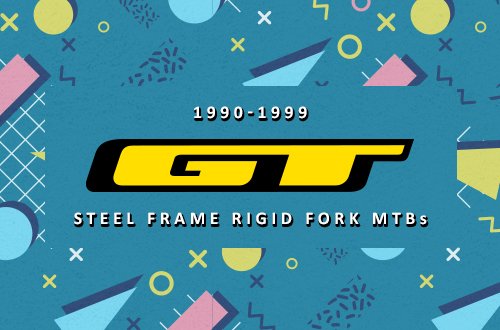

- 1994, Trek, 920
1994 Trek 920
- Specifications
- Description
- Value Guide
Frame & Fork
Bicycle condition guide.
- Bicycle Database
- Compare Bicycles
- Product Catalog
- Shop Categories
- Spoke Calculator
Copyright © BikePedia 2017 | Design by BikePedia.com | All rights reserved
- MAGAZINE OFFERS
- BIKE INSURANCE
- Best Products
- Maintenance
- Accessories
- Long-Term Reviews
- BikeRadar Podcast
- First Look Friday
- Bike of the Week
- Tech Features
- Routes and Rides
- Bike Galleries
- BikeRadar Bargains
- Buyer's Guides
- Fitness & Training
- Sizing & Fit
- Mountain Biking UK
- Cycling Plus
Trek 920 review
Trek’s hydraulic disc-braked take on the tourer
David Caudery / Immediate Media
Simon Withers
Comprehensive kit, quality components and an excellent, comfortable ride
No mudguards as standard but that’s about it if you’re happy with aluminium
With its aluminium frame, hydraulic disc brakes and thru-axles, it’s fair to say that the striking-looking Trek 920’s frameset is an outlier in the touring bike category.
It’s not only the frame and fork that are ploughing a unique furrow, though. Touring bikes are the last hangout of the triple chainset but Trek’s 920 has a double with small chainrings, emphasising the importance of lower gears.
But don’t be fooled: this Trek is every inch the full-on tourer that’s designed to carry you and nearly 40 kilos of your kit (a claimed 25kg at the back, 11.8kg at the front) – with a hefty overall weight limit of bike, rider and cargo at a claimed 136kg /300lb. In all my tours, I’ve never carried anything like 40kg.
- What is a touring bike?
- Road bike groupsets: everything you need to know

An aluminium frame instead of steel? One of the oft-repeated arguments in favour of steel is that if the frame fails in Uzbekistan or Uttar Pradesh all you need is to find a garage with a welder and your troubles are over.
There is an element of truth to this and I have met one cycle-tourist who did this. But, frankly, any ‘incident’ that writes off an aluminium frame is likely to do the same to its steel counterpart.
Years ago, my loaded aluminium tourer fell off a railway station platform onto the tracks. It came away with nothing more than a scratch. Fortunately, this was in rural New South Wales, one train a day in each direction. I also managed 3,000 miles in three months on that frame, some of it on poor roads.
The Trek 920 has a double chainset rather than a triple and it’s a move away from the Shimano hegemony with its 2x10-speed SRAM setup, which consists of SRAM S700 Double-Tap shifters (two) and GX derailleurs.
Crucially, while it may only have 20 gears compared with the 27 or 30 on the other bikes on test ( Fuji's Touring Disc , Cinelli's Hobootleg Easy Travel , Ridgeback's Panorama and Thorn's Club Tour MK5) this doesn’t compromise gears at the all-important lower end – the 28x36 is similar to the bottom gear on the other tourers.
The 42x11 top gear is actually the lowest top gear on test by a fair margin, though that’s rarely an issue when it’s fully laden.
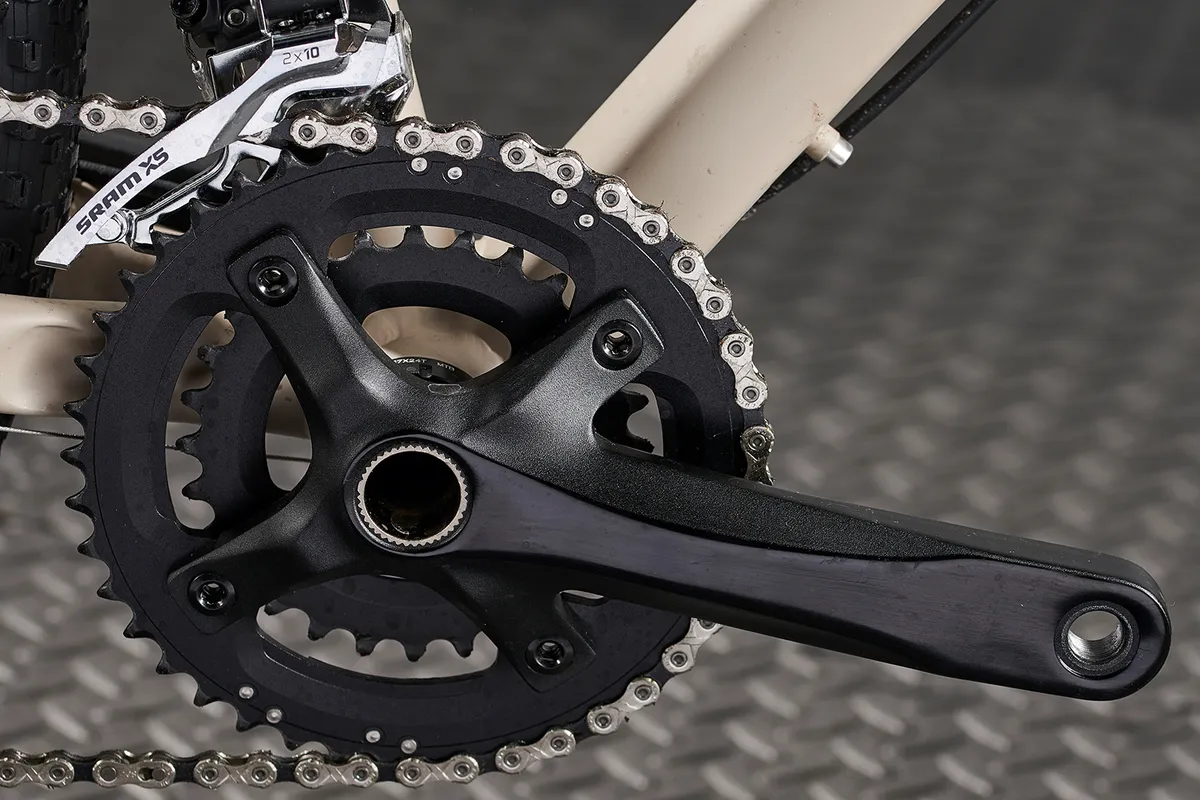
Trek 920 ride impressions
The 920’s ride is a sumptuous, king-of-the-road experience. Loaded up – with most of the weight at the rear – it’s stable, comfortable and tackles poor roads, grit, gravel and towpaths with barely a murmur.
Unloaded, or carrying little kit, the 920 is only negligibly slower than a road bike and as plush as you’ll need.
I got on with the saddle but not everybody will, and for a bike of this size you might want a slightly shorter stem for adventures.
But those are minor quibbles on a bike that I dare you not to like, even if its looks might cause a raised eyebrow among touring traditionalists.
The highlight of the component package is the braking. The cable-actuated discs elsewhere are easily adequate for touring (I’ve toured on cantis and caliper rim brakes with no problems), but SRAM’s hydraulic discs are a level or two above with great braking with minimal effort from your hands and arms.
Gear shifting from the DoubleTap levers is equally efficient, and you’ll pick up the technique within minutes if you’re coming from a Shimano background.
- Road disc brakes: everything you need to know
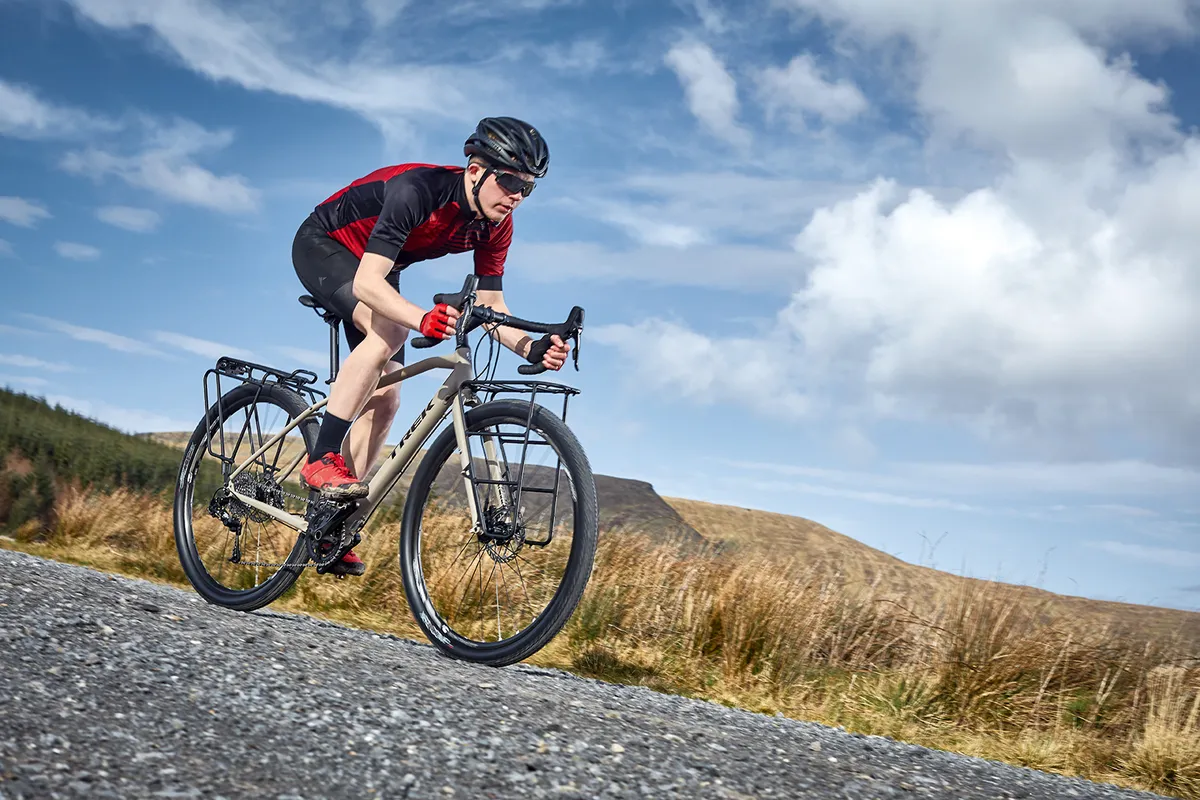
Part of the ride quality comes from the Bontrager Duster 29er rims and wide 2in XR1 mountain bike tyres, and both the rims and tyres are tubeless ready.
The 920 doesn’t come with mudguards but has the fittings for them – and mounts for just about everything else that you could carry, including triple-bottle bosses.
The 920’s Blendr stem is compatible with a wide range of dedicated computers , lights and other accessories. Very neat.
Trek 920 overall
The Trek is perhaps the most versatile bike in my test, doubling up as a day-to-day machine and full-on tourer, expedition, adventure or bikepacking bike.
It comes in at just 12.4kg in a 54cm frame with two panniers, and if you whip these off and fit narrower, slicker tyres (or even change to road wheels ) you’ll have a bike nearer 10kg; although it won’t be a crit-racing flyer, it will be comfortable, stable, very well appointed and that little bit sharper.

Trek 920 geometry
- Size (* tested): 49, 52, 54*, 56, 58, 61cm
- Seat angle: 74 degrees
- Head angle: 71 degrees
- Chainstay: 46.4cm
- Seat tube: 43.1cm
- Top tube: 54cm
- Head tube: 12cm
- Fork offset: 5.25cm
- Bottom bracket drop: 8.5cm
- Bottom bracket height: 28.2cm
- Wheelbase: 1,084mm
- Stack: 58.3cm
- Reach: 39.2cm
How we tested
This bike was tested against four other top touring bikes that have been designed to let you unlock your inner adventurer.
Other bikes on test:
- Fuji Touring Disc
- Cinelli Hobootleg Easy Travel
- Ridgeback Panorama
- Thorn Club Tour MK5
Share this article

Contributor

- Terms & Conditions
- Subscribe to our magazines
- Manage preferences

January 27, 2009
Trek singletrack 920.

4 comments:
The bike you have pictured is a 1998 Trek 920 SingleTrack (bright silver with mango decals). Although there is a Matrix SingleTrack wheel, which did come on many Trek 9xx Series SingleTrack bikes, the bike was not named after the wheel, they were both named after the most technically difficult level of mountain bike riding called "SingleTrack". The idea behind this is the trail is so rough and narrow it will only allow for one rider at a time. Trek SingleTracks were the flagships of the Trek steel Mountain Bike lines. Below them were the 8xx series Taiwanese made "MountainTrack", followed by the 7xx series "MultiTrack" (hybrids). Although steel will rust if left out, the fatigue life of a well built triple butted OX Comp II Chromo frame (like your 920) will allow it to far outlive any aluminum or carbon fiber framed bike around. Like your husband I swear by steel frames. My own 20.5 lb. rigid ’95 Trek 990 1x8 with newer high-end components is constantly mistaken for being aluminum because everyone knows “steel is heavy, isn’t it?”
Its a great bike. I have one and it its in silver with mango decals. Its been stuck in the garage for ages and comes out on occasions. We did part of National Cycle route 2 last weekend in the New Forest. All the bits on my bike are original and has no modifications As I said its a great bike. :)
Anyone know what one of these is worth? I have one and am thinking of selling it. Thanks...
I'd say between 100 and 200 dollars depending on the condition.
Post a Comment
1994 Trek 920 Singletrack

- Serial: 1273464
- Manufacturer: Trek
- Model: 920 Singletrack
- Primary colors: Purple
- Frame size: M
- Frame Material: Steel
Distinguishing features
Restomodded 90s Trek for fooling around town and party pace rides with friends on asphalt, gravel, dirt and rocks.
- Search forums
Follow along with the video below to see how to install our site as a web app on your home screen.
Note: This feature may not be available in some browsers.
- Mountain Bike --> 1997
- Retro MTB Chat
Help me understand the 90s Trek 920
- Thread starter Frankengoose
- Start date Feb 10, 2022
Frankengoose
Dirt disciple.
- Feb 10, 2022
I know this here is for bikes before 1997, but the 1998 Trek 920 seems to misplaced in time somehow. I checked the Trek catalogues available here and it is a full rigid chromoly bike and seems to have only been produced in 1998 (later Trek used 920 for a tracking/bike packing 29"). Trek didn't offer a 920 one two years before or after. The components are entry level, but it seems the frame is the same tripple butted steel as the better 930 to 970/90s. So Trek in 1998 thought: We have these insane amount of chromo frames lying around and can't get enough suspension forks, so let's offer a good old full rigid like a couple of years ago? This bike is nothing to drool about, still I find it interesting that Trek went against the norm and released a "retro bike" in 1998. It's not like they didn't have rigid aluminium bikes to sell.
fearfactoryüberalles
Senior retro guru.
- Feb 11, 2022
Yeah, by the late '90s pretty much all big players jumped on the stupid alloy/carbon bandwagon, so offering fine steel bikes as discount models weren't unusual at all. Sad story indeed (I'm pointing at you, Scott/Specialized!). The numbering -920- indicated its supposed "value for money, budget" image, hence the low level stuff on it. In 1999 they still offered a 930 with mid-range parts, but there's no evidence of their steel range after that year. Maybe some Gary Fisher bikes were built as steel mtbs in the early noughties, and of course the halo Bontrager bikes.
Trek Bike Models by Year and Color
Retro newbie.
- Mar 16, 2023
I correct myself: it is the 94 version
MattiThundrrr
- Mar 18, 2023
Steelinist said: Hi (my first post in the forum ) I am thinking of buying a 920 Trek in order to build it up as commuter. It is the 98th version. According to @joglo it would be top-notch frame? The low-standart components would be okay for me. Thanks for any answer in advance Click to expand...
Similar threads
- Mar 1, 2024
- Reader's MTBs --> 1997
- Mar 9, 2024
- Reader's Bikes 1998 -->
- Nov 12, 2022
- For Sale 1998 -->
- Sep 17, 2022
- Sep 2, 2021
Latest posts
- Latest: fguki
- 44 minutes ago
- 50 minutes ago
- 54 minutes ago
- Latest: chuckbiscuits
- Today at 03:00
- Latest: romanrinos
- Today at 02:05

- Forum Listing
- Marketplace
- Advanced Search
- Vintage, Retro, Classic
1993 Trek 930 Singletrack SHX worth updating?
- Add to quote
So I'll be moving out of the city soon and hopefully able to get back into mountain biking. With 2 kids, job, etc...it's been hard to get and ride out living in the city. I used to race when I was younger and had taken very good care of my Trek and upgraded most of it. It's still at my parents house and I've been thinking of picking it up when we move. I know I need to to fix a few things, BB, shock elastomers, cables, lube etc. Just wondering if it's worth fixing or selling it and buying something new. I know I can fix the shocks from a vintage shock site that sells refresher kits. but the rest not sure on, for example anyone know what size BB this bike had? I know this needs to be replaced, brakes were cantilevers and since I'd be running all new cables was thinking of upgrading them as well as the wheels.
Not worth a whole lot. Elastomers can be a *****. I'd do cables, lube. tires, etc and ride it for a while. If mountain biking takes, think about getting something newer then.
If you don't have a bunch of cash to blow, that's a hard bike to beat. Double butted True Temper frame, STX components, it's a blue collar trail beast if ever there was one. If you have a bit of discretionary income, buy a better 100ish mm fork, replace what else doesn't work, put at least some V brakes on it, perhaps a disc on the new fork along with a new wheel, and beat the crap out of it. In a few years, you'll either want a new ride, and have saved for it, or you'll appreciate it for what it is, a great tool to relax and unwind, and say it's good enough. Too many folks out there thinking they need the latest thing to have fun......
thanks for the info, I have a Manitu 3 on it now. would a 100mm fork work with the frame geometry? For $45 I can get new inserts for the shock as opposed to a few hundred for a new shock all together. thanks for the advice.
dgoak said: thanks for the info, I have a Manitu 3 on it now. would a 100mm fork work with the frame geometry? For $45 I can get new inserts for the shock as opposed to a few hundred for a new shock all together. thanks for the advice. Click to expand...
trailville said: I think 100mm would be too much for that bike. Click to expand...
Between the two, I'd say 80mm too, especially for a 93. And you are more likely to find a nicer fork used than a 100mm. Between the three, I'd go rigid and get some fat tires on it. Maybe even single speed.
MendonCycleSmith said: Not being argumentative here, but I'd disagree. A 150? Sure. that's a big old lever, but it'd handle 100 fine. It's a well built, sturdy, good name tubeset, etc. If he were a bruiser who wanted to dirt jump it, I'd concede to your point. In reading your thoughts though, I was struck with another thought. Simply pick up a travel adjustable version, It'd be in the 115 to 85 range, so you could find just right. I mentioned the slightly slacker 100 fork initially, as it will make the bike a bit more capable of handling the higher potential speeds going down hill, made possible by a fork that actually works Click to expand...
I'll third the rigid fork and fat tires option.. I also agree with Mendon on the comment about not needing the latest thing to have fun. A frame of that caliber would cost a whole lot more if it were being produced now, enjoy the classics because they represent value and quality we won't see again.
If you have a bit of discretionary income, buy a better 100ish mm fork, replace what else doesn't work, put at least some V brakes on it, perhaps a disc on the new fork along with a new wheel, and beat the crap out of it. Click to expand...
momosgarge said: What quality forks could he buy that have adjustable travel and can be set for 80mm? I am also curious because I am tied up in the same kind of project. Click to expand...
Does anyone out there know what year the frame design switched on these trek 930's? I have a 1991 single track version with the lugged tubes and I was told the rigid fork is made to stay on and I cannot put a suspension fork on. I have seen later models with just modern day steel look to them but what year did trek switch?
Check here... http://www.bikepedia.com/QuickBike/Default.aspx or here: http://www.mtb-kataloge.de/ Good luck! frog
The only difference between the regular model and shx was the shx came with a suspension fork and 1994 looks like the frame changed. Could have been before that but it only shows back until 94'.
I picked up what looks to be a stock 1993 Trek 930 SHX Singletrack at the flea market. After some online digging, I learned that this is a virtually bombproof bike, with solid Shimano Altus components. I'm a big fan of vintage bikes, especially lugged steel frames like this one has. Looks like the only real issue with this bike is the suspension fork. Not overly familiar with suspension forks (I'm originally a road bike rider), but looks like the fork is locked up. Any suggestions on how to proceed?
PaulCoffeeFreak said: proceed? Click to expand...
It's the original Shockwave fork, and yes, the elastomers appear to be toasted. If I'm not mistaken, this fork only allowed 1.5 inches of absorption. How much room, and what kind of shock fork am I looking for? I don't plan to ride too aggressively, mainly tooling around with the kids, some singletrack, basically trying to get fit again. I've been out of the cycling loop for 5 years or so...what's a decent suspension fork for this bike run these days?
like ameybrook said, rigid would be best.
Go rigid....
Yeah, that's the conclusion I'm coming to. Any suggestions on a rigid fork that will work with the brakes? I'm demonstrating my ignorance, but I think they're cantilever. It's the stock setup, because the triangular plate with the brake cable stop says TREK. Looks like it was made specifically for this fork. Ok, so...rigid. Next step?
I see rigid 26" forks all the time at local shops that sell used bike stuff. There's also ebay and cl. TONS of forks out there. I really like the Ritchey Logic forks and those come up for a good price fairly often.
The Ritchey Logic is a carbon fork, right? How well will they hold up under a Clydesdale? I'm not planning to do a bunch of jumping and real rough riding, but I see curbs and ditches in my future.
I have the same bike. My understanding is that 94 was the first year with suspension corrected geometry. You will want a 395 MM fork with a 45 mm offset.
Am I understanding you correctly that these measurements are for a rigid fork?
No photo of your 930? A-la before & after.
Soon as I can get them. I had to let the air out of the tires and remove the wheels, just to get it in the minivan. Didn't plan on buying a bike that day, don't you know. I haven't reassembled it yet, but plan to ASAP. Not really a fan of electric plum paint, but I couldn't ignore a solid Trek cro-moly lugged frame that was rideable. Especially not with the Rapidfire Altus shifters. Always liked those better than the gripshift.
Ah, I understand now. No bike co-op that I know about, but 3 very solid reputable LBS nearby. I'm sure between the 3 of them, somebody's upgraded a stock bike, leaving the stock fork behind. I'll keep those numbers in mind, see what I can dig up. Hopefully this won't happen: If they try to talk me into a suspension fork that they've taken off something else, what do I want to avoid? Any sketchy suspension forks I need to know about?
Pics coming as soon as I can get them uploaded!
- ?
- 15.5M posts
- 516K members
Top Contributors this Month
SORT CONTENT BY LOCATION
CLICK TO DRILL DOWN BY COUNTRY/PROVINCE
Your browser is ancient! Upgrade to a different browser or install Google Chrome Frame to experience this site.
Inspiration
- Bikepacking 101
- Join/Support

- View Latest/All
- Bikepacking Videos
- Your Stories
- Rider's Lens
- Field Trips
Popular Tags
- #bikerafting
- #Tour-Divide
- #family-bikepacking
- #winter-bikepacking
- #1Q5V (1 Question 5 Voices)
Gear/Reviews
- Bikepacking Bags
- Camping Gear
- Accessories
- #Editors-Dozen (Our Favorite Gear)
- #Gear-of-the-Year
- #MYOBG (DIY)
- #Decade-in-Review (Best of All Time)
The Gear Index
Latest indexes.
- Mini Panniers
- Saddlebags & Top Openers
- Cargo Cages & Anything Bags
- Gravel Bars
- Drop Bar 29ers
Bikepacking Bikes
- Rigid & Plus Bikes
- Drop-bar & Gravel
- Full Suspension
Rigs & Roundups
- Rider & Rig
- Race/Event Rig Roundups
- Worthy Builds
- Handbuilt Bikes
- #29+ (29-plus)
- #vintage-mountain-bikes
- #cargo-bikes
- Readers' Rigs (Dispatch)
- New Bikes (Dispatch)
Plan Your Trip
- Bikepacking Guides
- Bikepacking Food
- Gear & Pack Lists
- Bike Photography
Essential Reading
- Leave No Trace (for Bikepackers)
- Guide To Bikepacking Bags
- Bikepacking Gear That Lasts
- #Bikepacking-Awards
- Power Of An Overnighter
- Advice For New Bikepackers
- Our Favorite Bikepacking Routes
-
Where to Begin
We have over 300 original and curated bikepacking routes in our global network spanning nearly 50 countries.

Start at our worldwide routes map to dig into our detailed guides with GPS maps and inspiring photography.
By Location
- The United States
- Latin America
- Middle East
By Length (days)
- Overnighters & S24O
- Weekend Routes (2-4)
- Week-long Routes (5-10)
- Odyssey Routes (11-30)
- "Freakouts" (31+)
Local Overnighters
The Local Overnighters Project is a unified effort to document and map one-night bikepacking routes all over the world—by locals, in their own backyards.
The Bikepacking Journal is our biannual printed publication. Each issue features a collection of inspiring writing and beautiful photography. Find details on the three most recent issues below, join the Bikepacking Collective to get it in the mail (anywhere in the world), or click here to find a collection of selected stories in digital format.

The special edition 10th issue of The Bikepacking Journal is one you won’t want to miss! It features 25% more pages with extra stories, bonus art and maps, and much more...

Issue 09 takes readers on trips through time—one to the early days of bicycles—and offers several reminders to be grateful for supportive friends and family, and strangers we meet along the way...

For Issue 08, we invited several contributors to return and pick up where earlier trips and ideas left off and also feature a handful of first-timers whose perspectives we’ve long been eager to share...

Reader’s Rig: Nick’s 1991 Trek 970 Singletrack
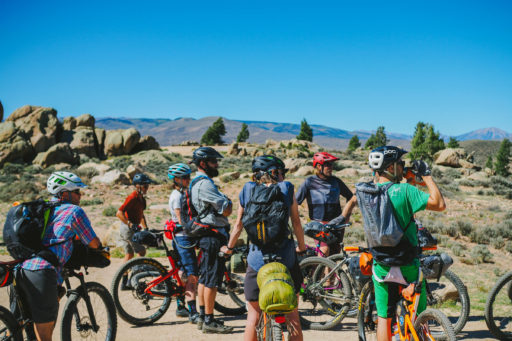
Previous Dispatch From Thu Mar 28, 2019
Registration Open for 2019 Bikepacking Summit
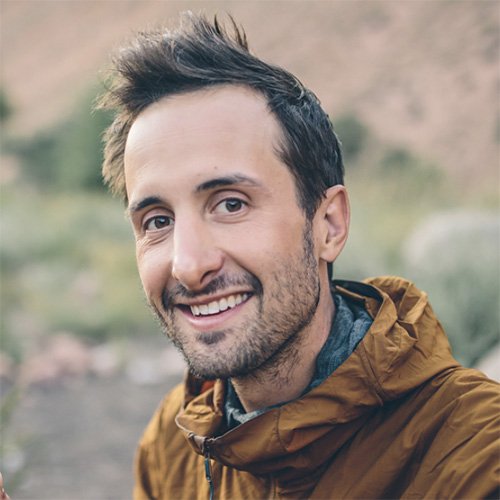
This week on Reader’s Rig, we scope out Nick Karwoski’s 1991 Trek 970 Singletrack, built up for trips around town from mostly repurposed parts. Find more photos and build details here…
My name is Nick Karwoski and I’m originally from Wisconsin but now live in Austin, Texas. I’m a recovered roadie who discovered touring first, then bikepacking. I try to get out on trips as much as my life allows, but end up commuting a lot more than touring.
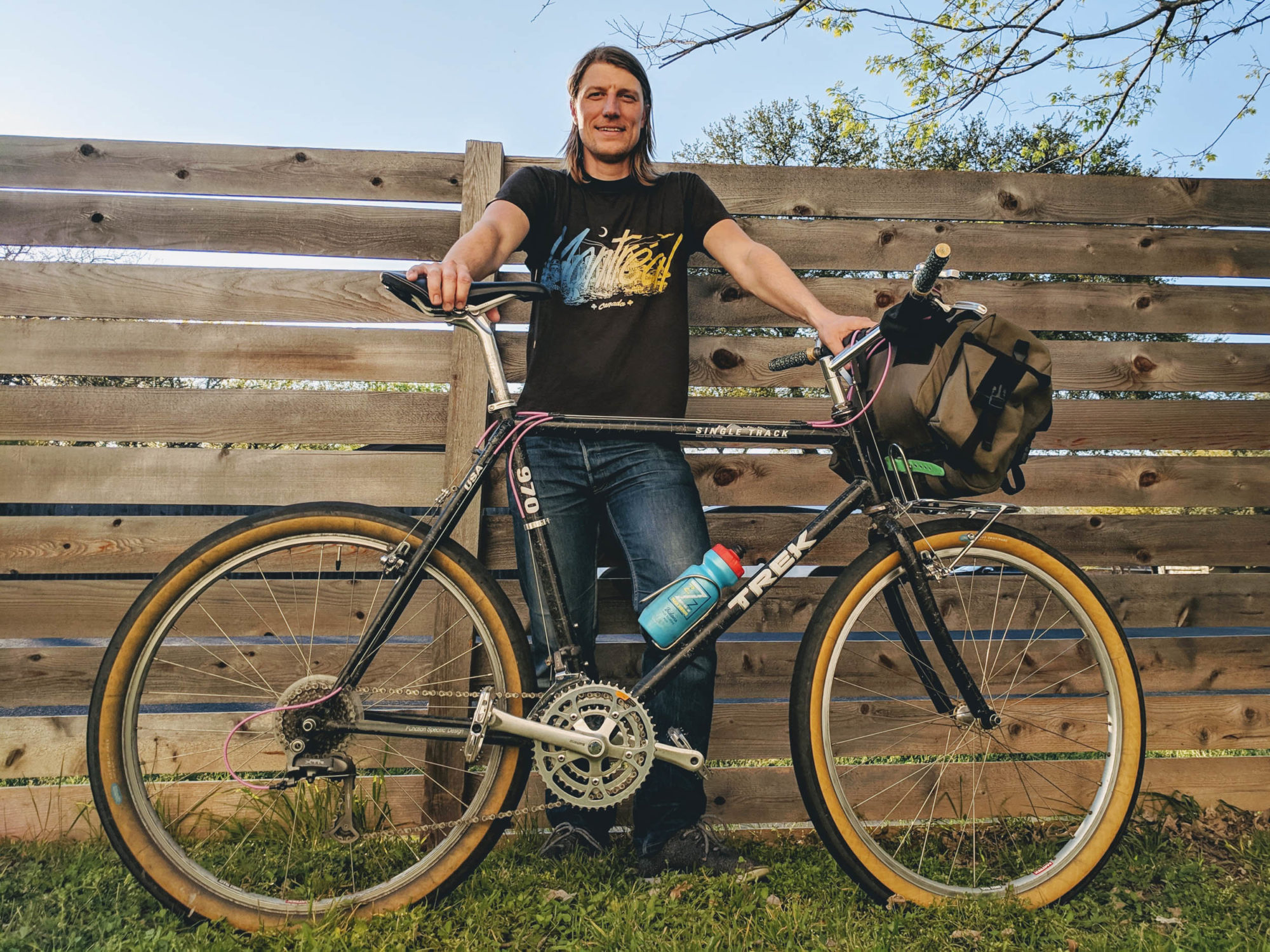
I’d been interested in building up a a Trek 970 for a while and recently found a nice 970 XL frame at the right price, so it was time to take the plunge. My bike is a 22” 1991 Trek 970 Singletrack, mostly used for commuting, around town trips, and #coffeoutsideatx.
I salvaged a lot of the parts from a bike Co-op in Austin, used what I had lying around, and bought a few items on eBay. The bars are 1” Nitto Bullmoose attached to a Shimano STX 1 ⅛” headset with an adapter (I’m still alive). The bar tape is Serfas with .12 gauge shotgun shells for bar ends. The brake levers are Shimano Altus. The shifters are SunTour Power Thumb friction shifters. I used a Shimano Deore XT (M730) triple crankset with 9-speed XTR front (M953) and rear derailleurs (M952 Long cage). The wheels are Matrix rims, mystery hubs, a 7-speed cassette, and Compass Rat Trap Pass tires. The brakes are Tektro CR720s. The seatpost is a Velo Orange attached to a Fyxation Pilot saddle. I drilled out the fork crown hole (a tiny bit) to attach a Nitto M12 rack. The bag is a large Fabio’s Chest (the chest is the best!).
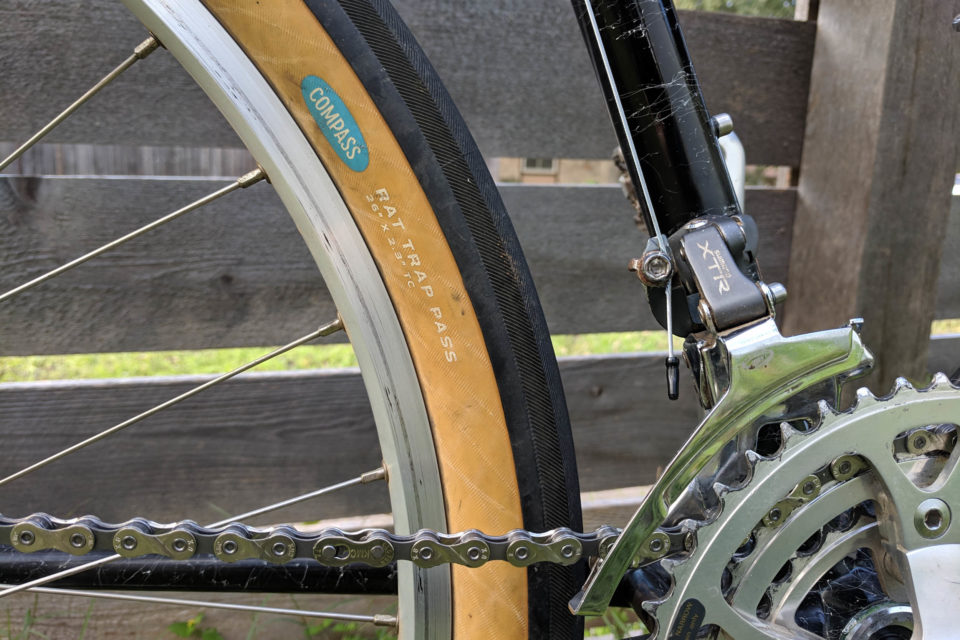
- Frame/Fork 22” 1991 Trek 970 Singletrack
- Rims Matrix 26″
- Hubs Unknown, the name has worn off!
- Tires Compass Rat Trap Pass
- Handlebar Nitto Bullmoose
- Crankset Mystery 7 speed cassette
- Cassette Shimano XT 11-46
- Derailleur(s) 9-speed SHimano XTR M953 (front) and Shimano M952 long cage (rear)
- Brakes Tektro CR720
- Shifter(s) SunTour Power Thumb friction shifters
- Saddle Fyxation Pilot
- Front Rack Nitto M12
- Front Bag(s) Swift Industries / Ultra Romance Fabio’s Chest
This bike really wants to you to stand up and mash on the pedals, just like the bikes you rode as a kid. All in all, this build was relatively inexpensive and fun to put together, and almost everything was reused. You can find it (and me) on #coffeeoutsideatx leisure rides in the ATX area.
You can follow Nick on Instagram at @bicycleexplorersclub .
FILED IN (CATEGORIES & TAGS)
Reader's rig.
Please keep the conversation civil, constructive, and inclusive, or your comment will be removed.
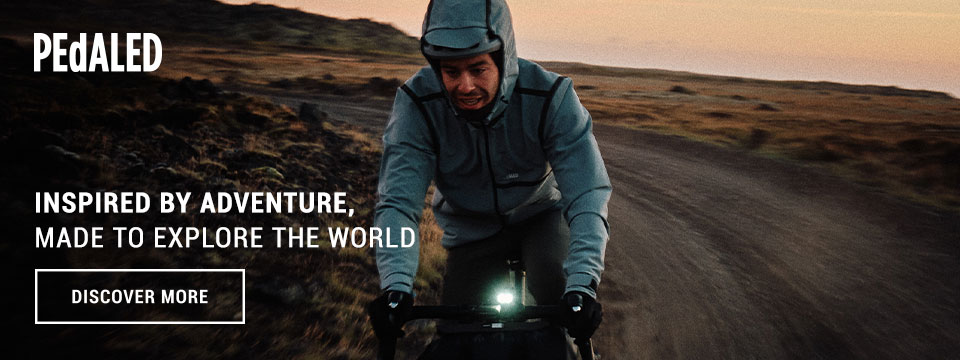
Rad Companies that Support Bikepacking

You need to be logged in to use these features. Click here to login , or start an account if you’re not yet a member of the Bikepacking Collective…
Expecting a paywall?
Not our style, and not everyone can afford to pay for content right now. That is why we keep the majority of our routes, reviews, and reports open for everyone to enjoy. But, if you can, there are three good reasons to support us: 1. We’re independent and not funded by a multi-million-dollar corporation; 2. Our quality reporting and up-to-the-minute news is authentic, unbiased, and presented in an ad-lite browsing experience; 3. A membership costs less than a coffee per month, helps support all the content on the site, and gets you The Bikepacking Journal twice per year.
Already a member? We’re grateful for your support. Login to hide this message *Join by April 17th and start your membership with Issue 12 of The Bikepacking Journal
Symbol Matches
Symbol starts with, company matches.
- International
- Switzerland
The Radisson was something of a gem, by Moscow standards. Tatum and his partners had taken a desolate, pre-perestroika concrete skeleton and transformed it into a gathering place for foreign and Russian entrepreneurs, with a steak house, Parisian fashion boutiques, and a glittering lobby bar. In 1990, Presidents George Bush and Mikhail Gorbachev had blessed the 430-room riverfront tower as a shining example of the role joint ventures could play in Russia's slow, sanctioned march away from Communism.
But by 1996, the Radisson had become a model of how severely such ventures could go wrong. The Russian stake had changed hands three times and was being administered by a charming young Chechen whom Tatum suspected of having ties to the mob. Western lenders, fearful of Moscow's deteriorating business climate, had turned down Tatum's loan applications. Tatum had appealed to the public for funds to pursue his lawsuit, hoping other Western businessmen would, in effect, invest in his $35 million damages claim.
So when a call came late on a Sunday afternoon last November from someone with information--or offering to help finance his case, was it?--Tatum leaped to the phone. After a rapid conversation in English, he grabbed his coat and headed with two bodyguards for the dingy metro station a stone's throw from the Radisson. Tatum's Russian partners long before had taken away his cream-colored Mercedes. Lately the metro was the safest means for him to get around anyway, and certainly the cheapest. Bankers and other important people "got killed in cars," he reminded anyone who would listen.
The three men--Tatum in the middle, a bodyguard fore and aft--hustled out the hotel gates and past the Kievsky train station's pageant of kiosks, cabbies, and street vendors. They took the first steps down to the seedy underpass below, and in the darkening five o'clock hour, Tatum's killer, his Kalashnikov rifle wrapped in a plastic bag, took aim.
Very few, except perhaps Tatum himself, foresaw that the son of Edmond, Oklahoma, would die by violence. True, in the seven years he spent in Moscow, friends came to see Tatum as a sort of crusader defending foreign investors' rights in the ever more barbarous Russian business environment. And critics--he had many--felt his inability to let go of a project that outgrew him had drawn Tatum into an obsessive, deliberately public battle for control. But until now, Western business people had been mostly immune from the gangland brutality passing for commerce in Russia. Tatum often said he carried a shield: He believed that if he kept his case firmly in the public eye, he might safely wage the kind of anti-mafia battle that other businessmen only wished they could. He took out newspaper ads, gave interviews promiscuously, and sought out politically connected Muscovites. "In our joint venture, and in most cases where there are problems, there is fringe or deep mafia involvement, and people are scared to put themselves at risk," Tatum said in an interview seven weeks before his death. "I have put myself so much in the open that it's only later when I'm going to have to worry."
For a Westerner, Tatum was reasonably well connected in Moscow--among other things, he had scrambled over the barricades of the besieged parliament building during the Soviet Union's collapse in 1991 to offer Boris Yeltsin's aides the use of his cellular phone--but he remained a naif in many ways. He ended up running a multimillion-dollar venture more on the strength of persuasive charm than of expertise. "Paul had not had any business experience running a company," says Bernie Rome, one of Tatum's original backers.
But Tatum was a convincing talker from his earliest days. When he was an undergraduate at Oklahoma State University, he persuaded friends to pool the money to send him on a "semester at sea" aboard a sort of sailing classroom. He tasted travel, and commerce too: On the streets of Tunis, he earned a quick 300% profit and a few thousand dollars selling cigarettes bought from the captain of his ship.
Tatum dropped out of college after his junior year and made what was, for a young person, a clever but genuinely odd career move: He borrowed $10,000 and donated it to the Republican National Committee. A donation that size made a person a "Republican Eagle" and guaranteed a certain amount of access. Tatum, perceiving a route to prominence, plunged into GOP fundraising in Oklahoma.
It was on an Oklahoma trade mission to Russia in 1985 that Tatum fell under the spell that Gorbachev's perestroika had cast on much of the West: a market of nearly 200 million Russians hungry for Levi's jeans, and Detroit cars with automatic transmission. Tatum took special note of the bewildered foreign businessmen negotiating million-dollar deals on crackling phones in drab Soviet hotel rooms. What Moscow needed, he was sure, was a place for these people to do business: a shiny, Western-style hotel and business center in the heart of the capital, where corporate cowboys could get a room, buy a bourbon, rent an office, do a deal. "It was as if I found myself standing on a mountaintop from which I could see everything; my past, my present, and my future," he said later.
Tatum knew his deal had to be a joint venture. Gorbachev had just legalized them, and about the only way Western businessmen could penetrate this market was to take a Russian partner. Tatum needed a Western partner too: he had no money and no idea how to build or run a hotel. Now his Republican Party ties paid off. Tatum formed a company called Americom Business Centers in 1989, and H.R. "Bob" Haldeman, Nixon's former chief of staff, out of jail and dabbling in hotels, hooked up Americom with Apollo Acquisitions, a tiny holding company in Florida that was publicly traded, had cash to invest, and was looking for a good idea. Apollo and Americom merged.
That same year, Tatum found his property: a gray, half-finished monstrosity on Moscow's Berezhkovskaya Embankment, facing east toward the Moscow River. It was owned by Intourist, the Soviet tourism monolith, which wanted to erect a hotel that could earn hard--that is, foreign--currency.
Tatum started talking to big U.S. hotel chains and found that Radisson Hotels International was itching to establish a beachhead in the Soviet Union, then a closed market. And so a three-headed joint venture was born: Tatum's Americom held a 40% stake, Radisson 10%, and Intourist 50%. Radisson would manage the hotel's rooms and restaurants, and Americom would manage its retail shops, office space, and other services. The venture was called Intourist-RadAmer Hotel and Business Center.
Of course, there were problems, as there always were in Russia. Intourist was still run by Soviet bureaucrats; the Yugoslav construction company refused to hand over the master keys after finishing the hotel, wanting to cut itself in on the deal; Radisson was testy about which floors would serve as hotel rooms and which Americom would lease as office space to business clients.
But by 1990 the Radisson Slavyanskaya (meaning "Slavic") was up and running, and it quickly became Moscow's poshest new address. Bill Clinton, Al Gore, Warren Christopher, and their armies of security men swarmed over the hotel during summits with Yeltsin; Sharon Stone sashayed across its polished marble floors; the NBC and Reuters Moscow news bureaus anchored the high-hat tenant list. In the hotel's European restaurants, expatriates clinked imported beers and ate sirloins, grateful to escape the slog of daily life in Russia, if only for a few hours.
Then, the ground shifted.
Western businesses learned quickly that the "Wild East" held many perils, and all of them seemed to befall Tatum's venture. First, the Soviet Union came apart. No one knew what belonged to whom, or whether contracts signed under Soviet rule would remain valid. In Radisson's case, the new Russian Federation fell to sparring with the old Soviet tourism machine about who owned the Slavyanskaya property. After months of wrangling, ownership was transferred to the Moscow City Council, and Tatum found himself with a new Russian dance partner. That spooked Tatum's banks in the West, which withdrew their promise of roughly $20 million in commercial loans. Tatum decided to run the Americom business center from cash flow, violating the original joint venture charter and enraging his new Russian partners. But Tatum felt he had no choice: There were offices to renovate, furniture to buy, salaries to pay.
Outside the Slavyanskaya's climate-controlled opulence, a new class of biznesmeni--some of them legitimately self-made millionaires, most of them not--cropped up almost overnight. Once-underground mafia like Moscow's Solntsevo ("Sunny") gang, bosses of the shadow economy in the Soviet years, were criminalizing nearly every facet of Russia's economy. The new musclebound tycoons donned black turtlenecks and Armani blazers to party in members-only night spots like the Metelitsa casino and the exclusive Up and Down club. Foreign cars of every make cruised like sharks over Moscow's crumbling streets. Hoods murdered elderly pensioners for their newly privatized apartments. When consumer price inflation hovered around 1,600% between 1992 and 1993, housewives worked late shifts as casino prostitutes to make ends meet; policemen would sometimes give them a lift to their shifts, if bribed on time.
Murder evolved into a business strategy, and high-profile killings were an early part of Russia's post-Communist collective memory. Vladislav Listyev, the popular television journalist, was shot dead outside his apartment in a crime linked to control of the lucrative TV advertising market. Ivan Kivelidi, chairman of the Russian Business Round Table, was killed by nerve toxin, applied, it was said, to his telephone receiver. The year 1995 produced roughly 560 recorded contract killings. Police solved just 60; of them, two-thirds were found to have been committed by the victims' bodyguards.
The Russian business community was decimated. "I take a look around this room," says Oleg Kiselev, the new president of the Russian Business Round Table, "and I see about a dozen empty seats. All my friends."
The deliberate, gangland-style killing remained a Russian affair, however. When Western businessmen were threatened, they generally fled. A few, though, like Tatum, clung to the peculiarly American belief that Russia would bend to the inevitability of progress, free markets, the rule of law, and the force of their will.
In a baldly political move, President Yeltsin in 1993 handed Moscow mayor Yuri Luzhkov exclusive control over privatization of property and businesses within the city limits, in effect a monopoly on one of Europe's most lucrative real estate markets. So Tatum had a new Russian partner once again: the Moscow City Property Committee, which overnight rose up as the most potent agency in town, a smoothly running profit center with a percentage cut in nearly every Russian and foreign business setting up shop. The Property Committee eventually settled on a dapper Chechen businessman, Umar Dzhabrailov, to represent its interest in the Radisson Slavyanskaya.
For the moment, though, Tatum's major problem was with his American partners, who accused him of using money from the company to live above his means. Nights he could be found at Moscow's decadent hot spots seated at a front table, waving hundred-dollar bills at Russian ecdysiasts. Tatum's backers sued him in Florida, alleging misuse of company assets. "Tatum told investors what they wanted to hear until he got what he needed," says James McDonough, founder of Apollo Acquisitions, the company that merged with Americom. "The court was his friend when it could fend people off, but the law didn't apply to him. When he broke it, he'd say, 'Go ahead and sue me. I'm in Russia...you can't do anything to me.' "
Radisson too was flexing its muscles. It provided stopgap funding during the venture's cash crunch, and it claimed that in return it was owed a larger stake in the RadAmer partnership. Tatum sued Radisson, and that same day, Radisson sued him back. John Norlander, then president of Radisson Hotels International, says, "We wanted to manage a hotel and ... to expand globally. He wanted the same thing, we thought, and to manage the business center for fees." But the headstrong Tatum hated ceding as much as a hint of control, even when his financial straits called for compromise. Radisson and Americom began to clash over everything, swapping accusations of bad management and shoddy bookkeeping. Eventually, in 1994, Radisson went to court in Minneapolis and sought to have its partnership with Americom dissolved. As Norlander describes it, "Paul had a personal problem that spilled over into a business problem."
Tatum began to tell associates about plans to bring in a deep-pocketed rescuer to solve his cash difficulties. "As soon as he gets here, you'll see," Tatum said of a reputedly wealthy Pakistani he'd invited to Moscow. The investor never showed up, getting only as far as Frankfurt's airport before being arrested for shoplifting.
In 1995, a federal judge in Minneapolis ruled that Radisson and Americom should sever their partnership, each retaining independently its stake in the Moscow property. In his ruling, the judge said the partnership should be dissolved, partly because the parties were "unable to trust each other." By that time, though, Tatum had much bigger problems.`
Inside the hotel, the tone had changed. Tatum's Russian partners kicked out the nonprofit International Press Center for nonpayment of rent and talked of filling the space with a disco, or worse, a casino. The lobby bar had a new clientele. Men in black turtlenecks with lumps under their blazers began to outnumber the ex-pats in suits and ties. Leggy Russian jezebels strolled in and out of the hotel's retail stores, looking bored and fetching in Chanel suits and impossibly high heels.
In the spring of 1994, Tatum accused the joint venture's general director, a man named Vladimir Draitser (whom Tatum himself had recruited) of embezzling funds. Tatum cut Draitser's phone lines and access to bank accounts, barred him from the hotel, and declared his contract expired. Draitser posted a brigade of guards at the Slavyanskaya entrance to keep Tatum out. Not long afterward, a crack team of Moscow police raided the hotel lobby bar and held ten alleged gangsters at gunpoint.
"There has been a putsch," Tatum reported breathlessly at an impromptu press conference that day in the hotel driveway. No one could figure out who called the police. But suddenly there were lots of guns being pointed around the Slavyanskaya.
Tatum won a court order allowing him back into the hotel. He returned with a battalion of bodyguards and refused to leave, camping out in his office. He might have left the country, but as his old friend Matt Seward puts it, "It was still Paul's dream, and still Paul that made it happen. If it were your dream, and your tens of millions of dollars, would you leave?"
Tatum didn't have the kind of formal government support enjoyed by multinationals like Exxon or British Telecom, with billion-dollar investment carrots to dangle in front of Russian industry. Seward, for one, believes that "if Paul had been an executive at a Fortune 500 company instead of an entrepreneur, he'd still be alive." But he wasn't, so he bet his life on the courts, and on the power of publicity.
Tatum began telling reporters that Umar Dzhabrailov, the city of Moscow's representative on the joint venture's board, was a Chechen mafia lord. (Much later, Dzhabrailov was identified by the Russian Interior Ministry as a "known contract killer, and one of a handful of Chechen mafia bosses operating in Moscow.") When President Clinton arrived at the hotel for a summit meeting, Tatum handed out 300-page binders documenting his legal battles and accusing Moscow officials of corruption in their dealings with the hotel business. He titled this tome The Environment for Business Success in Russia; on the cover, in bold red letters, was printed the word DECEASED.
On Valentine's day 1995, one of Tatum's bodyguards, on his way back from the bathroom to Americom's offices, was stabbed in the chest with a penknife. His assailant said, "Tell Paul it's high time he left for home." Tatum hired a 24-hour brigade of guards, started wearing a bulletproof vest, and began using a cellular phone exclusively, contending his phone lines were bugged.
For the better part of a year, the Slavyanskaya resembled a chessboard. The Russian side forced out tenants that hadn't paid; Tatum let them back in with his master key so they could continue supporting him in his fight against the joint venture.
That April, Tatum decided to pitch what he hoped would be a decisive battle, filing a $35 million lawsuit against the Moscow City Property Committee for discriminating against foreign investors. The case would be heard in Stockholm at an international arbitration court, which increasingly had been sought out by embittered Westerners seeking an escape route from deteriorating joint ventures. But Tatum needed $150,000 to pay court costs. So he took out full-page ads in Moscow newspapers offering to sell investors "Freedom bonds," promissory notes that would pay back a 100% return in six months, when he expected to be flush with court-awarded winnings. The bonds were to mature on April 2, 1997, his 42nd birthday.
In an interview at the Slavyanskaya shortly before he was killed, Tatum was asked whether, considering the circumstances, Freedom Bonds might be a bit of a risk. "In one sense, they're risky," Tatum sighed, as if he had considered it for the first time. "But in another sense, they're something that people can support without being noticed. You can vote for the good guys and get rewarded." Then he smiled winningly. As Star Trek music played on his computer, he said, "Like war bonds, which provided money to fight World War II, Freedom Bonds allow us the right to fight for freedom of investment, safety in investment, all of the words of investors' rights. Is this society one of the rule of law and of civil means, or is it a society of whoever has the biggest gun or the most money to pay people off? This case can be the first example showing that the rule of law can be enforced, and can make a difference in creating a civil, safe investment environment."
Tatum's killer took considerable care even with the date, according to Alexander Fefelov, a former KGB agent with his own security firm and an adviser to the American Chamber of Commerce security subcommittee. Sunday evening, November 3, was the perfect time for murder. Because of an upcoming midweek Wednesday holiday, many people were stretching the weekend into five days. Thomas Pickering, the longtime American ambassador in Moscow, had recently left his post; an interim ambassador was on duty. The U.S. embassy would close Tuesday to observe Election Day back home.
The 5.45-caliber Kalashnikov assault rifle was fired so expertly as to rule out a nonprofessional. Five of the 12 bullets entered at the neck, indicating the killer knew Tatum might be wearing his bulletproof vest. Whoever fired was well trained in preventing the weapon's powerful kick from spraying passersby. Both Tatum's bodyguards were unharmed.
The shooter threw down the rifle, serial numbers filed off, and leaped into a white Zhiguli sedan, perhaps the most common make in Moscow. The same day the car was found ten minutes from the scene on Rostovskaya Embankment, unlocked and empty. A week before, police said, the owner had sold it for $5,000 cash at an outdoor market to a man who did not give his name.
On January 27, the Stockholm tribunal handed down its judgment--in favor of the Russian partners' claims that Americom had diverted funds to offshore bank accounts and failed to keep proper accounting records. Americom's management contract to run the retail shops and business center is to be "terminated," and Americom to pay $2.6 million in damages to the Russian partners.
Few expect Paul Tatum's killer to be found. Russian Interior Minister Anatoly Kulikov, who has said he is personally supervising the investigation, pointed to the long-running dispute over control of the joint venture as the likely motive. But he did not rule out the curious theory that the killing was somehow connected to the U.S. presidential elections. Moscow Western District prosecutor Alexander Yegorov says that in view of Tatum and Dzhabrailov's well-known "conflict," Dzhabrailov remains a suspect. Dzhabrailov says he had nothing to do with it. "It's nonsense," he said not long after the shooting.
Congressman Christopher Cox (R-California) has been pushing to keep the case on front burners at law-enforcement agencies in Russia and the U.S.; Tatum had been appealing to Republican congressmen, through his old RNC contacts, before he was killed. But even Cox is pessimistic. He wrote to FBI director Louis Freeh that "the grip of organized crime on Moscow's city government is so pervasive that, absent intense outside scrutiny, [Tatum's] killers will never be brought to justice."
Whoever shot Tatum is "probably no longer alive," says Natalia Bokadorova, a longtime girlfriend who believes his death could have been sanctioned only by someone at "the highest levels" of the Russian government. It's even possible, she contends, that Tatum stepped into the middle of some unknown battle between the city of Moscow, mafia groups, and the federal government--all of which would like a slice of the Radisson gem, with its lucrative, cash-rich operations. In his final months, Tatum had appealed to a lot of powerful people about rescuing his vision. Bokadorova figures that someone offered coercive terms to Tatum and sent an assassin when Tatum wouldn't bend. Whoever committed this crime, she says, "had a plan, but Paul didn't accept it. He told me, 'I don't want to change one mafia for another.' "
REPORTER ASSOCIATE Maria Atanasov
Shooter Files by f.d. walker
Street Photography Tips, Interaction, Travel, Guides
Apr 24 2017
City Street Guides by f.d. walker: A Street Photography Guide to Moscow, Russia

*A series of guides on shooting Street Photography in cities around the world. Find the best spots to shoot, things to capture, street walks, street tips, safety concerns, and more for cities around the world. I have personally researched, explored and shot Street Photography in every city that I create a guide for. So you can be ready to capture the streets as soon as you step outside with your camera!
At over 12 million people, Moscow is the largest city in Russia and second largest in Europe by population ( Istanbul is #1). An urban, cosmopolitan metropolis with more than enough glitz and glam to cater to the elite, but without losing its fair share of Soviet era roughness around the edges. It can be fast paced, brash, busy, and trendy like other big cities, but it has its blend of West meets Russia atmosphere and beauty that provides plenty of unique interest. The Red Square is as famous as it gets, but there’s so much more to this city, including the most beautiful subway system you’ve ever seen. It would take years to capture all of Moscow, but that means you have an endless amount of areas to discover.

So here’s a Street Photography guide so you can be ready to capture all that Moscow has to offer before you even arrive!
- Patriarch’s Pond
- Old Arbat Street
- Maroseyka Street
- Tverskoy Boulevard
Top 5 Street Spots:
1. red square.
The Red Square is the most famous square in not just Russia, but all of Eastern Europe. The name actually doesn’t come from the color of the bricks or communism, but from the name in Russian, Krásnaya, once meaning “beautiful” before its meaning changed to “red.” This large plaza is what you see on the cover of guide books and magazines for Moscow, with St. Basil’s Cathedral being the center piece next to Lenin’s Mausoleum surrounded by the Kremlin Wall. Of course, the Red Square attracts hordes of tourist due to the main attractions, but all that activity around an interesting atmosphere does provide street photo opportunities. It’s also the central square connecting to the city’s major streets, providing a good starting point to explore outward.

You’ll also find the popular pedestrian only Nikolskaya Street connecting the Red Square to Lubyanka Square. This line of expensive shops includes plenty of activity, while also leading you to another popular square. Filled with history rivaling any city, the Red Square and surrounding areas are the heart and soul of Russia.

2. Patriarch’s Ponds
Patriarch’s Ponds is one of the most exclusive neighborhoods in Moscow. Despite the name being plural, there’s only one large pond, but it’s worth a visit with your camera. It’s a popular spot for locals and expats to come relax or take a stroll around the pond. You get an interesting mix of young and old too, from young love to “babushkas” feeding pigeons. It’s a very peaceful park atmosphere in one of the nicer areas within the city center, while bringing enough activity for street photography.

The pond is shallow and in the winter becomes a popular spot for ice-skating too. The area is also well-known for the location in the famous Russian novel, The Master and Margarita.
3. Old Arbat (Stary Arbat)
Old Arbat is the most famous pedestrian street in Moscow, and dating back to the 15th century, also one of its oldest. Originally, it was an area of trade, but soon became the most prestigious residential area in Moscow. During the 18th century, Arbat started attracting the city’s scholars and artists, including Alexander Pushkin. Cafes lined the streets and impressive homes filled the neighborhood. Since then, New Arbat street was created as a highway in the area, while Old Arbat was paved for a 1km pedestrian only walkway.

Due to the historic buildings, famous artists that lived here, and the bohemian atmosphere, Old Arbat has become a big attraction for tourists today. Now, there’s a mix of cafes, restaurants, souvenir shops, street performers, street merchants and other attractions for visitors, and some locals, to come enjoy. It can get really busy here and there’s usually something interesting going on so it’s a good street to come walk with your camera for guaranteed life.
4. Gorky Park
One of the most famous places in Moscow is Gorky Park. The official name is Maxim Gorky’s Central Park of Culture & Leisure, which gives you an idea of what goes on here. When built, it was the first of its kind in the Soviet Union. Divided into two parts, it stretches along Moscow River. One end contains fair rides, foods stands, tennis courts, a sports club, a lake for boat rides, and more. This end brings more active life due to its number of attractions, while the other end is more relaxed, where you’ll find gardens, trees, older buildings, and an outdoor amphitheater.

Gorky Park attracts mostly locals so it’s a good spot to capture the non-tourist side of Moscow life. Muscovites come here to escape the city and unwind in a picturesque setting. The park remains alive outside of the warmer months too, especially when the lake turns into the city’s largest outdoor skating rink. I’d recommend taking the metro out here to spend at least half a day exploring the massive park’s life with your camera.
5. Maroseyka Street
Maroseyka Street is a popular area not too far from the Red Square. The long, winding street turns into Pokrovka and is lined with restaurants, cafes, bars and places to stay. It’s actually where I like to stay when I’m in Moscow due to its location and solid street photography opportunities itself. You have Kitay-gorod station near and if you keep walking southwest, you’ll get to the Red Square. But if you walk northwest, as it changes to Pokrovka, you can find a long street of activity for photography with its own interesting atmosphere.

6. Tverskoy Boulevard
Tverskoy Boulevard is the oldest and longest boulevard in Moscow, beginning at the end of Nikitsky Boulevard, and finishing at Pushkin Square, a spot to come for activity itself. The boulevard is made up of two avenues, with pedestrian walkways in-between. You’ll find grass, shrubbery, trees, benches and more walking it’s almost kilometer length. Many people come here to enjoy some relaxation, walk their dog, or just to use it to walk wherever they’re going. Its center location also provides a nice place to walk with your camera near plenty of other spots you’ll want to check out anyway.
Sample Street Walk:
For a full day of Street Photography, covering some of the best spots, you can follow this sample street walk for Moscow:
- Start your morning walking around the Red Square (1), while exploring the surrounding area, including Nikolskaya Street
- Then walk northwest to Patriarch’s Ponds (2) and slowly walk the pond and surrounding area with your camera
- Next, walk east to the Pushkin Monument and stroll down Tverskoy Boulevard (6)
- Once Tverskoy Boulevard (6) ends, it will turn into Nikitsky Boulevard. Follow this down until you get to the start of Old Arbat Street (3), across from Arbatskaya station
- After you’re done walking down Old Arbat Street (3) for more street photography, spend some time checking out Moscow’s beautiful metro stations
- To finish off the day with more street photography, get off the metro near Red Square (1) again, Maroseyka Street (5) or wherever you’re staying for the night.

3 Things I’ll Remember about Shooting in Moscow:
1. museum metro.
The Moscow metro system was the first underground railway system in the Soviet Union and today includes 203 stations across 340km of routes. The elaborate system has some of the deepest stations in the world too, with escalators that seem to go on forever. None of this is what makes it so special, though. Many of its stations feel like stepping inside a museum, making it without a doubt the most interesting and beautiful metro system I’ve been in.

When built, Stalin wanted to make the metro stations “palaces for the people” with marble, chandeliers, and grand architecture. The best part is the variety of architecture and styles used, making many of the stations a completely different experience visually. You could easily spend a whole day traveling the stations and there are even tours available for people who wish to do just that. My advice, though, would be just to buy a ticket and hop on and off at different stations, while exploring different lines. The museum-like surrounding mixed with the crowds of characters can make for a great photography experience.

Since there are so many stations, here are some of my favorites to check out:
- Novoslobodskaya
- Mayakovskaya
- Elektrozavodskaya
- Komsomolskaya
- Ploschad Revolyutsii
- Dostoyevskaya
- Prospekt Mira

2. Moscow is Big
It’s no secret that Moscow is a big city, but it can feel even bigger with how spread out much of it is. This is especially true if you compare it to cities outside of Asia. If I compared it to cities in Europe, I’d probably say only Istanbul would warrant more time to really discover the depths of this city. Most only explore around the Red Square and surrounding area, but that is such a small part of the city. Although, that central area does give you plenty to see on its own.

Fortunately, I had a good friend living in the city to show me around, but it opened up my eyes even more to how much there is to discover in Moscow. It’s a big city with a variety of atmosphere that can take you from “east” to “west” and trendy to rugged depending on where you go. I’d imagine you’d have to live here a while to really know the city.
3. Cosmopolitan Mix of East meets West
Modern skyscrapers mixed with amazing architecture, a world-class metro system with museum-like beauty, trendy fashion and chic clubs, Moscow is a rich mix of Russian culture and history in a more western cosmopolitan package. There is a push to keep the Russian culture, while also pushing forward with a modern metropolis the whole world will envy. This comes with an impressive skyline, that continues to grow, and endless modernities, but with soviet nostalgia and atmosphere mixed in for good measure.

Mixed in with this grand western cosmopolitan atmosphere, is a strong national pride in Russia. This includes their famous leader, Vladimir Putin. Maybe no other place will you see a country’s leader more often. All over, from the pricey tourist shops to the underground walkway stalls, you’ll find goods with Putin’s likeness covering them. From t-shirts to magnets to Matryoshka dolls. There’s a strong national pride that can be seen around the city, which also extends to their leader. Moscow is many things. It’s East meets West, modernizations meets Soviet era, and a whole lot more.
What To Do For a Street Photography Break?:
Eat at a stolovaya.
Stolovayas are Russian cafeterias that became popular in the Soviet days. You grab a tray and walk down the line of freshly prepared local dishes, and select whatever you want from the chefs. They’re usually inexpensive and a much better value than restaurants, while giving you the opportunity to try from a wide selection of everyday Russian food. They’re also very tasty. I always include some borsch on my tray and go from there. The places themselves are all over Moscow and usually come with Soviet-era aesthetics to complete the experience.

Street Safety Score: 7
*As always, no place is completely safe! So when I talk about safety, I’m speaking in general comparison to other places. Always take precaution, be smart, observe your surroundings and trust your instincts anywhere you go!
Being the 2nd largest city in Europe with over 12 million people, you’re going to have your dangerous areas, but for the most part, it feels safe walking around. Russia is statistically higher in crime compared to most of Europe, but this generally doesn’t apply to tourists and visitors. Around the Red Square and surrounding city center, you should feel completely safe walking around. Pick pocketing can happen, but no more than other touristic places. I always explore Moscow freely without coming across too much to worry about. It’s a spread out city, though, so of course it matters where you are. Just use basic street smarts, know where you are and Moscow shouldn’t give you a problem.

People’s Reaction Score: 7
Moscow is fast paced, big city life, which usually means people aren’t too concerned with you, or your camera. I don’t find people notice or pay much attention to me when I’m out taking photos in Moscow. For the most part, people just go about their day. You shouldn’t get too many looks or concern. But it can depend on the area you are in. The more you stick out, the more you might get noticed with suspicions. I’ve never had any problems in Moscow, or Russia, but just be careful who you’re taking a photo of if you get out of the city center. Other than that, it’s about average for reactions.

Street Tips:
Learn the alphabet .
Much of Moscow, including the metro system, doesn’t use english. The Russian alphabet uses letters from the Cyrillic script, which if you aren’t familiar with it and don’t know the sounds, can be hard to decipher the words. This is most important for street names and metro stops when trying to get around. It can save confusion and make it easier getting around if you learn the basic alphabet. At the very least then, you can sound out the words to see which are similar in the english conversion, which can help matching them to maps. When out shooting street photography, getting around is as important as anything. So save yourself some time and frustration by learning the Russian Alphabet.

Use the metro
While Saint-Petersburg feels very walkable for a city its size, Moscow can feel very spread out, even for its bigger size. Outside of the Red Square area, you can have plenty of walking before getting anywhere very interesting, so you’ll need to take the metro a lot if you really want to explore the city. Maps are deceiving here too, it will always be further than it looks.

Another reason it’s less walkable than Saint-Petersburg is its completely different set-up. Moscow’s streets are mostly contstructed in rings with narrow, winding streets in-between. This is common with medieval city cities that used to be confined by walls, but you usually don’t have it in a city this massive. Saint-Petersburg has a more grid-like pattern that also uses the canals to help you know your way around. When it comes to navigating on foot in Moscow, it can be more difficult, so bring a map and take the metro when needed. It’s why Moscow’s metro carries more passengers per day than the London and Paris subways combined.
Explore other areas if you have time
Moscow is really big. While most people stay around the Red Square within the Boulevard Ring, there’s so much more to the city. I covered some other spots outside of this circle, but if you really want to see the city, you’ll need time. If you do have time, some other areas I’d check out first are Zamoskvarechye, along some of the south and western Moscow.

Inspiration:
For some more inspiration, you can look through the Street Photography of Moscow photographer Artem Zhitenev and check out 33 of my photos taken in Moscow .
Conclusion:
Moscow’s name brings a certain mystique, but once you’re there it might bring a different atmosphere than you expect. It’s big and sprawling, but beautiful in many ways. It can feel like a European capital on a grand scale, but you can definitely find its Russian side in there.

The urban sprawl of Moscow can be intimidating, but give it enough time and you’ll be rewarded with plenty to discover. All with the world’s best metro system to take you around.
I hope this guide can help you start to experience some of what Moscow contains. So grab your camera and capture all that Moscow has to offer for Street Photography!
If you still have any questions about shooting in Moscow, feel free to comment below or email me!
(I want to make these guides as valuable as possible for all of you so add any ideas on improvements, including addition requests, in the comment section!)
Click Here For More City Street Guides!
(A New Guide Posted Every Other Wednesday)

Comment Here! Cancel reply
For patreon exclusive educational content:.

Limited Edition Postcard Prints!
Street Photography Workshops
Donations Always Appreciated
I'll always keep Shooter Files free for everyone, but any donations would be greatly appreciated and help me keep it going. Many thanks to everyone following along!
Cheers! -f.d. walker
Search the Files

For Exclusive Patron Content:
Russia Travel Blog | All about Russia in English
- About our blog
- RussiaTrek.org
Sidebar →
- Architecture
- Entertainment
- RussiaTrek.org News

- Send us a tip with a message
- Support RussiaTrek.org
- Travel Guide to Ukraine
- Comments RSS
← Sidebar
Stalin’s Soviet Union – Moscow in 1953-1954
No comments · Posted by Sergei Rzhevsky in History , People , Photos
Major Martin Manhoff spent more than two years in the Soviet Union in the early 1950s. He worked as an assistant to the military attache in the U.S. Embassy, located near Red Square.
Manhoff, being a gifted photographer, shot hundreds of scenes from everyday Soviet life – both in Moscow and in other regions of the USSR.
Construction of the hotel “Ukraina” from the roof of the U.S. Embassy on Novinsky Boulevard. On the left you can see the Church of the Nine Martyrs of Cyzicus (1954).
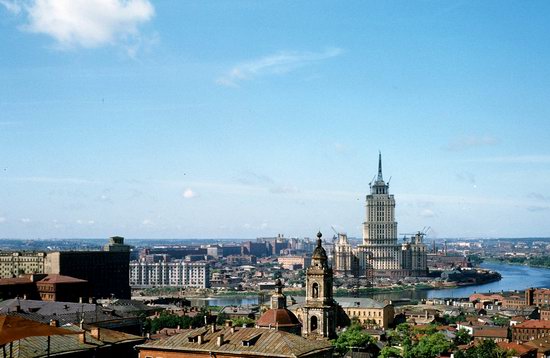
After the accusations of espionage, he left the country with hundreds of color slides and negatives taken during his time in the USSR. Among these materials was the shooting of Stalin’s funeral – one of the turning points in Soviet history.
Hotel “Moskva” on Manezh Square.
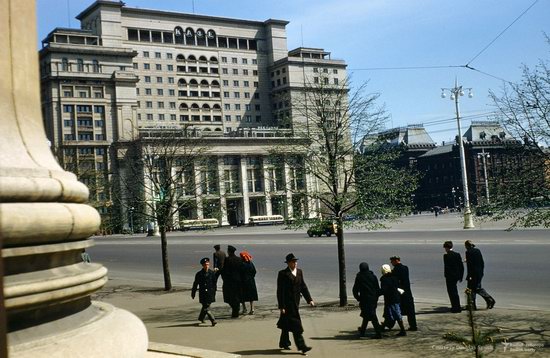
The Kremlin from the entrance to the U.S. Embassy.
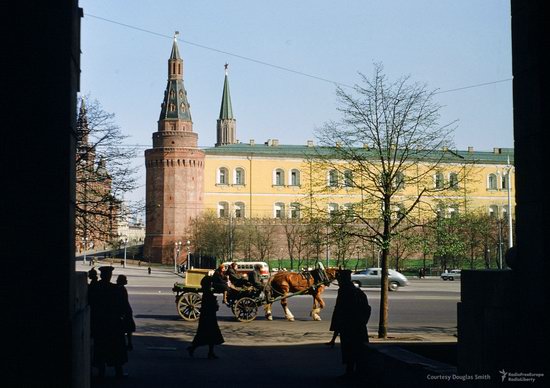
In 1953, Red Square was not yet closed to traffic.
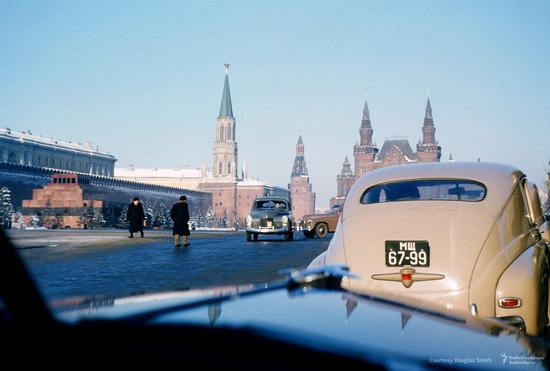
Approaching the intersection of Okhotny Ryad and Tverskaya Street.
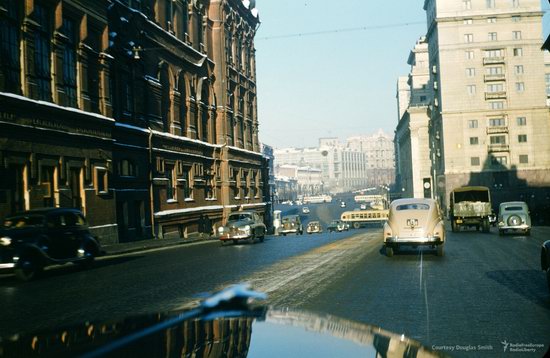
Movie theater “Khudozhestvenny” on Arbat Square.
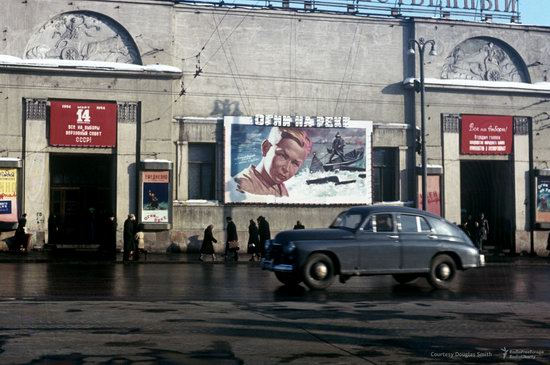
Theater Square.
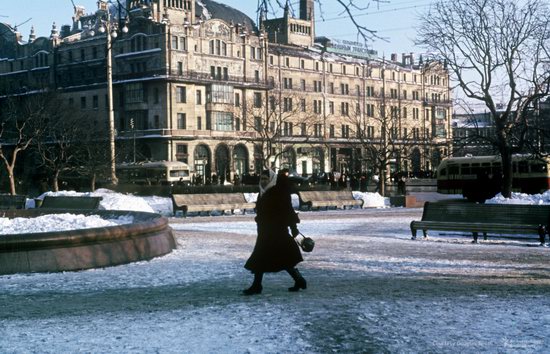
Driving up Bolshaya Nikitskaya Street.
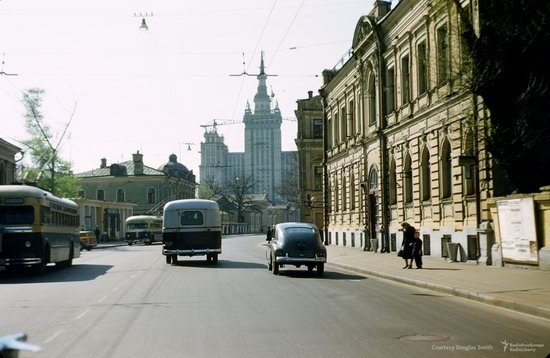
The Trinity Lavra of St. Sergius.
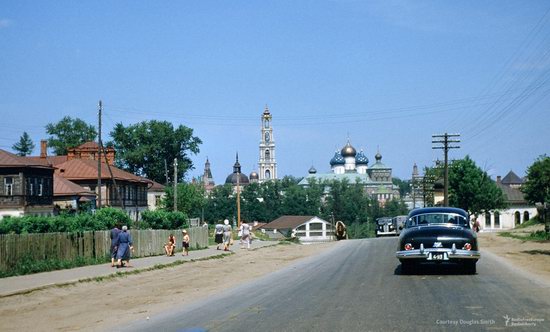
Novinsky Boulevard, 18.
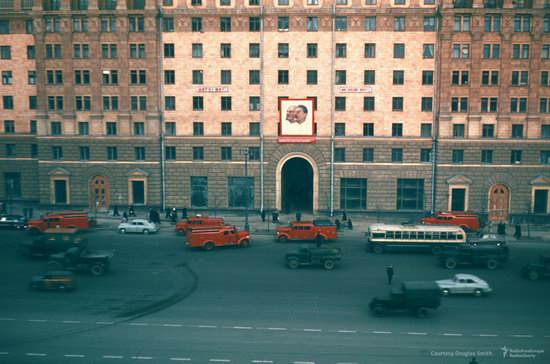
Storefront at Theater Square.
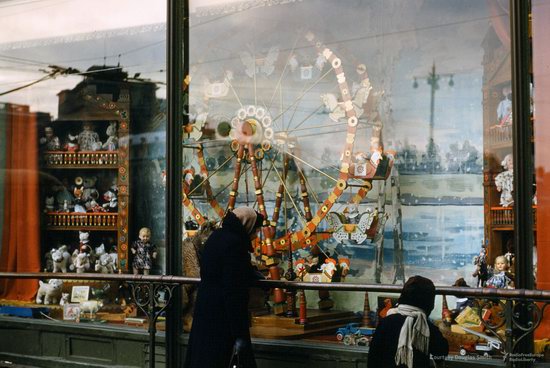
Novospassky Monastery.
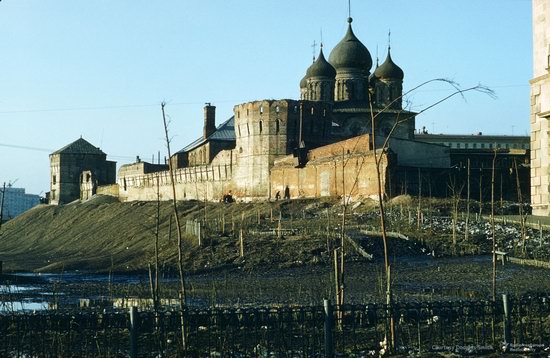
The corner of Bolshoi Devyatinsky Pereulok and Novinsky Boulevard.
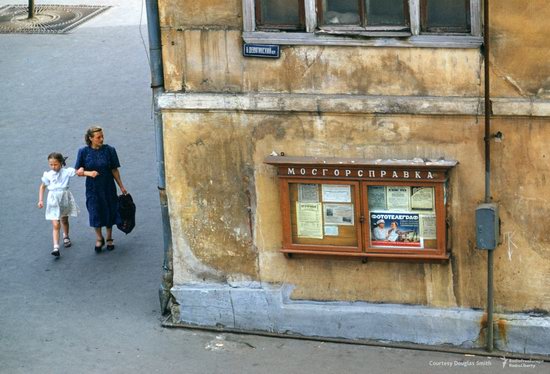
The view from Vorobyovy Gory.
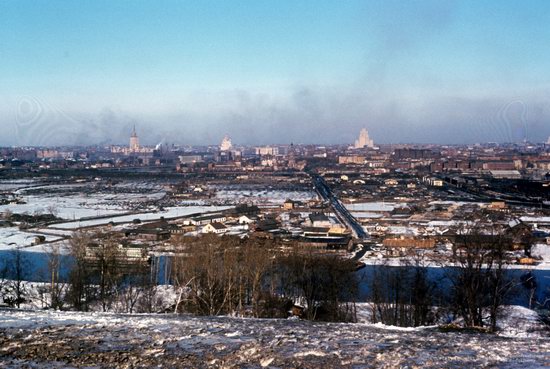
The newly built main building of Moscow University in the night illumination.
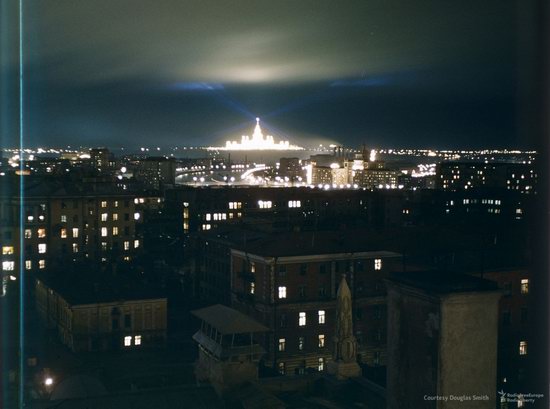
The funeral of Stalin.
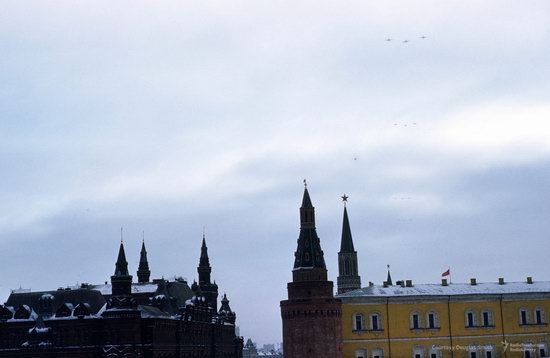
Celebration at Manezhnaya (Manege) Square.
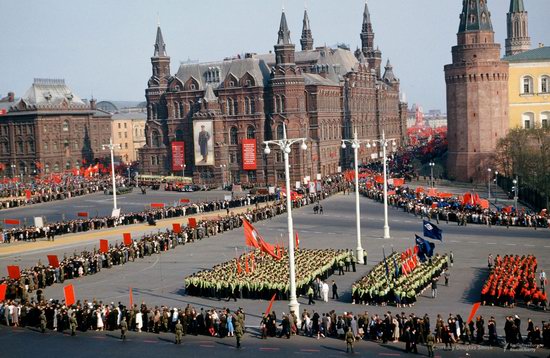
Pushkin Square.
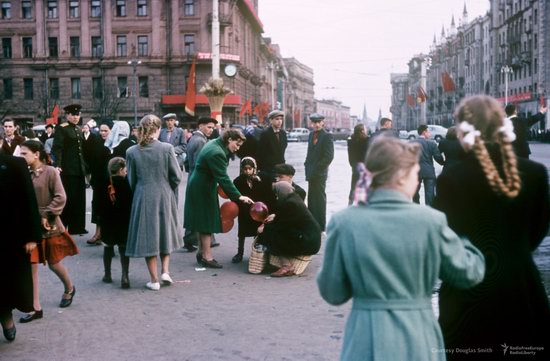
The building of the Central Telegraph.
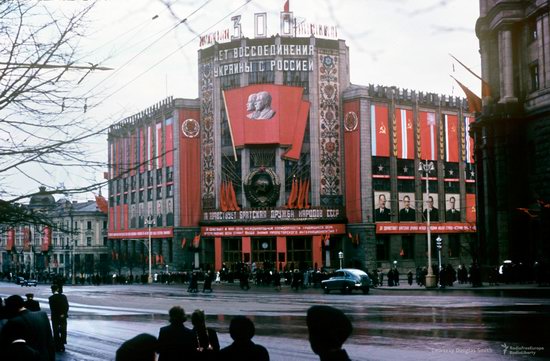
Moscow Zoo.
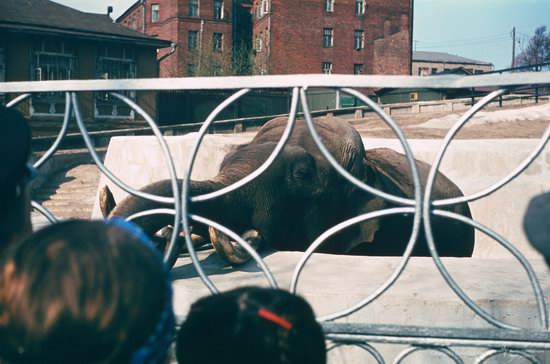
In the pool of Moscow State University.
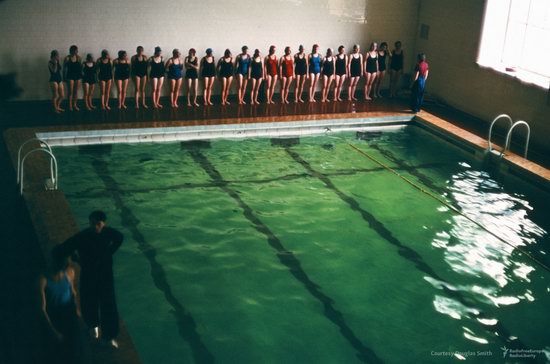
Metro station “Park of Culture”.
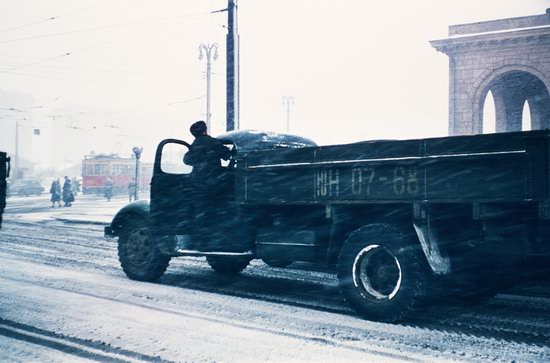
The second part of photos
Tags: Moscow city · Soviet past
You might also like:
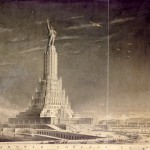
Vyborg – the only historic town in the Leningrad region
Winter in the Art Park Nikola-Lenivets >>
No comments yet.
Leave a reply.
XHTML: You can use these tags: <a href="" title=""> <abbr title=""> <acronym title=""> <b> <blockquote cite=""> <cite> <code> <del datetime=""> <em> <i> <q cite=""> <s> <strike> <strong>
- February 2024
- January 2024
- December 2023
- November 2023
- October 2023
- September 2023
- August 2023

IMAGES
VIDEO
COMMENTS
1994 Trek Catalog. This is an extract from the 1994 Trek Catalog. It contains details on the two steel-framed road bikes that Trek made this year: models 520 and 370. It is followed by two tables that contain the specifications for all of the 94 Trek bikes. The colors for the various bike models are included in the tables. All of the pages can ...
This is an adventure-biking sub dedicated to the vast world that exists between ultralight road racing and technical singletrack. All-road, crossover, gravel, monster-cross, road-plus, supple tires, steel frames, vintage bikes, hybrids, commuting, bike touring, bikepacking, fatbiking, single-speeds, fixies, Frankenbikes with ragbag parts and specs, etc. are all fair game here.
The Trek 920 Singletrack was only made for two years, 1994 and 1998. 1. Reply. 84K subscribers in the xbiking community. This is an adventure-biking sub dedicated to the vast world that exists between ultralight road racing and….
5. ★★★★★. ★★★★★. Strength: Perfect single track geometry, strong frame and fork, stable wheels, lovely ride. Weakness: Cheap and heavy bottom bracket (even lasted ten years), plastic pedals. I am the first owner of this bike purchased in 1995. Jumped to Shimano SPD pedals and Selle Italia saddle after few years.
The 9XX series, called Single Track, consists of a range of race, competition and performance bikes, aimed at pro riders and serious off-road enthusiasts. ... Trek 920 SingleTrack Performance (1994) Trek True Temper custom butted & TIG welded Cro-moly Trek System 1 butted Cro-moly fork 14.5, 16.5, 18, 19.5, 21" Ice Violet w/ Gold decals ...
Find out how much a 1994 Trek 920 bicycle is worth. Our Value Guide is constantly growing with pricing information and bicycle specs daily. VALUE GUIDE; BUY. SELL/TRADE. BIKE FINDER; ARTICLES; SIGN IN. Compare; Cart. ... 1994. 1998. 2018. 2019. 2020. View All Reviews. Share. Not eligible for trade in.
Wheel Size: 26" wheels: Hubs: Shimano STX: Rims: Matrix SingleTrack Comp, 36-hole: Front Tire: 26 x 2.10" Trek Control Track System: Rear Tire: Not Available: Spoke Brand
Joining the ranks of the 'adventure bike', the Trek 920 aims to rewrite the classic touring rulebook. Skyler takes one to B.C. to find out what this means. ... Furthermore, the low bottom bracket and bar-end shifters make it very challenging to ride the 920 on even relatively easy singletrack. Perhaps it's because I'm used to riding modern ...
Add a review. 0 Singletracks members own this. #155 out of 243 Mountain bikes. Brand: Trek. 1998 Trek, rigid mountain bike. Trek 920 Singletrack Mountain bikes reviews and prices. See how the Trek 920 Singletrack rates.
Sizing: Seat tube c-c (cm/in): 49/19.3, Top tube c-c, (cm/in): 59/23.2, 24-speed, Trek used to make its nice steel frames by hand in Wisconsin, and this is one of them. The Singletrack line was the company's best steel mountain bikes. The 990 was the best, but the 920 was no slouch with True Tempter OX II tubing. This 920 has so many upgrades it might as well be a 999.
How does the Trek 920 perform as a touring bike? Find out in this comprehensive review by BikeRadar.
The Trek 920 bike, is a non-suspension mountain bike. According to BikePedia.com, the year of the 920 was 1994. I think it was called a Trek Singletrack because the wheels that are on the bike, also made by Trek/Bontrager are called Single Track. Made of steel, the 920 will be relatively heavy compared to aluminum bikes that were made more ...
Purple 1994 Trek 920 Singletrack, serial: 1273464.
Yeah, by the late '90s pretty much all big players jumped on the stupid alloy/carbon bandwagon, so offering fine steel bikes as discount models weren't unusual at all. Sad story indeed (I'm pointing at you, Scott/Specialized!). The numbering -920- indicated its supposed "value for money, budget" image, hence the low level stuff on it.
Model 554644. Retailer prices may vary. 920 is a go-anywhere adventure touring bike. It's built with drop-bars and 29er mountain bike wheels for balance and capability on any surface you'll encounter on a bikepacking expedition. It comes with front and rear racks for a ridiculous amount of carrying capacity, so all you have to do is pick a spot ...
PaulCoffeeFreak. 24 posts · Joined 2011. #17 · Oct 31, 2011. I picked up what looks to be a stock 1993 Trek 930 SHX Singletrack at the flea market. After some online digging, I learned that this is a virtually bombproof bike, with solid Shimano Altus components. I'm a big fan of vintage bikes, especially lugged steel frames like this one has.
Frame/Fork 22" 1991 Trek 970 Singletrack. Rims Matrix 26″. Hubs Unknown, the name has worn off! Tires Compass Rat Trap Pass. Handlebar Nitto Bullmoose. Crankset Mystery 7 speed cassette. Cassette Shimano XT 11-46. Derailleur (s) 9-speed SHimano XTR M953 (front) and Shimano M952 long cage (rear) Brakes Tektro CR720.
In the spring of 1994, Tatum accused the joint venture's general director, a man named Vladimir Draitser (whom Tatum himself had recruited) of embezzling funds. ... As Star Trek music played on ...
*A series of guides on shooting Street Photography in cities around the world. Find the best spots to shoot, things to capture, street walks, street tips, safety concerns, and more for cities around the world. I have personally researched, explored and shot Street Photography in every city that I create a guide for. So you can be […]
Among these materials was the shooting of Stalin's funeral - one of the turning points in Soviet history. Hotel "Moskva" on Manezh Square. The Kremlin from the entrance to the U.S. Embassy. In 1953, Red Square was not yet closed to traffic. Approaching the intersection of Okhotny Ryad and Tverskaya Street. Movie theater ...
Find out how much a 1998 Trek 920 bicycle is worth. Our Value Guide is constantly growing with pricing information and bicycle specs daily. VALUE GUIDE; BUY. SELL/TRADE. BIKE FINDER; ARTICLES; SIGN IN. Compare; Cart. Sign in; Create account; Profile; ... 1994. 1998. 2018. 2019. 2020. View All Reviews. Share.
Tons of awesome Moscow HD wallpapers to download for free. You can also upload and share your favorite Moscow HD wallpapers. HD wallpapers and background images